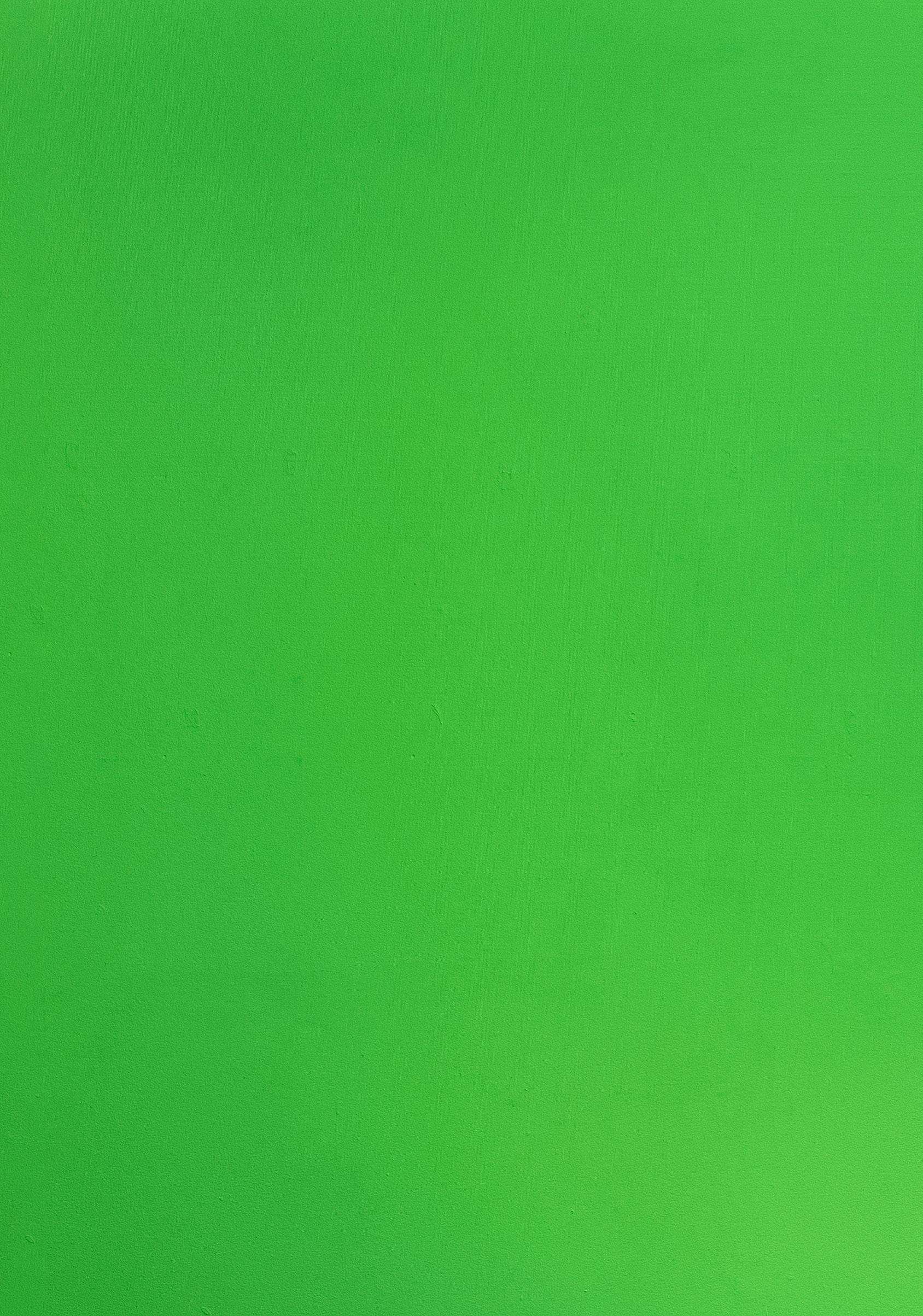2023 MFA GRADUATE THESIS EXHIBITION





 Current Glass, sand, tea lights, fire 10" x 6' x 6'
Current Glass, sand, tea lights, fire 10" x 6' x 6'
Throughout my life I’ve developed an appreciation for diverse landscapes. Finding inspiration in forms of nature that dwarf human power and can be seen in clouds, rivers, waterfalls and mountain peaks. It’s within the motion and intensity of the glass studio that I utilize the elements of wind, water, fire and earth, balanced harmoniously, to create paintings indicative of mythical landscapes. It’s through connecting to the emerging spirit of creation that flows through me that I hope to inspire engagement with nature in our increasingly fastpaced digital world.

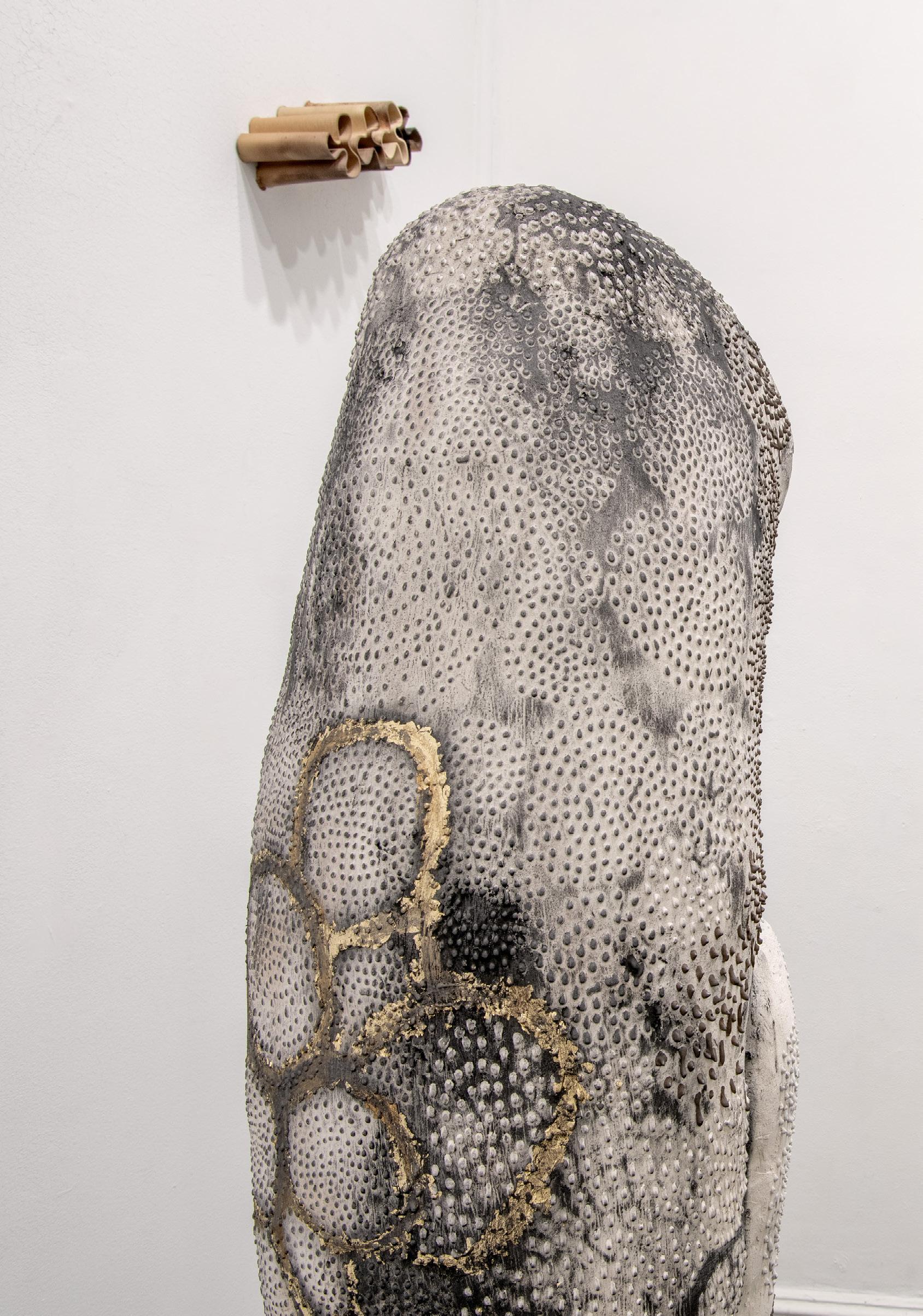
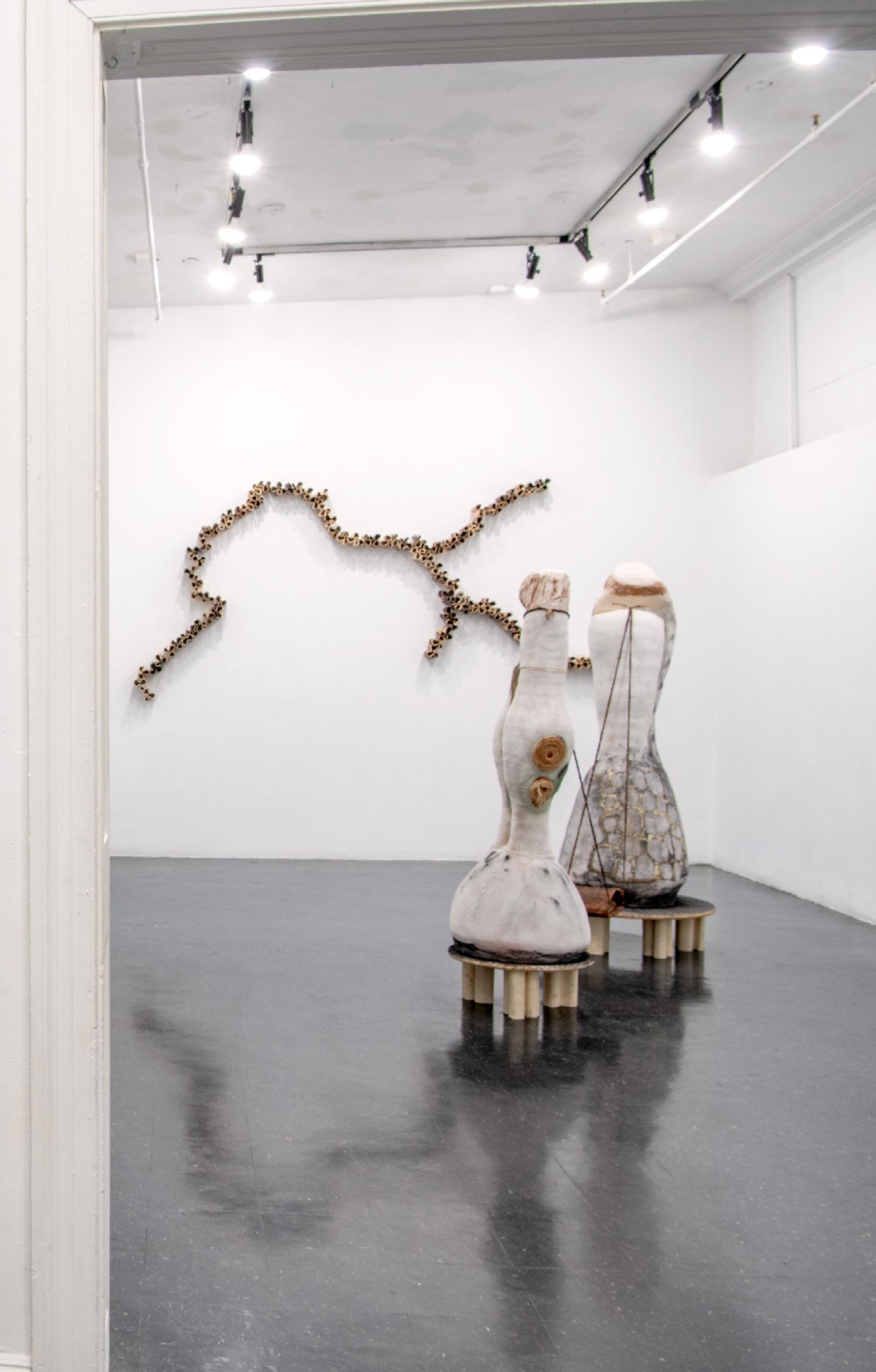
Nyasha Chigama
My work focuses on examining some of the experiences of immigrants in different settings and situations. Specifically, it examines the moments of living between African culture and American culture. I also explore the cultural, social and political location of the contemporary Zimbabwean woman. I do this in an autobiographical fashion through documentation of these experiences.
My conceptual idea is to document the journey of the two cultures that I am experiencing and capture the beauty of this
experience. I have created one large vessel that signifies my stay in the United States thus far and another that signifies my stay in Zimbabwe. The vesptures have elongated necks that are facing each other but they are both connected with a swing in the middle. The swing is made out of a very light form. The 3D printed ceramic vessels installed in the shape of a map from Richmond and a map from Goromonzi are symbolic of the interactions I have had in these two places and how all these have shaped the way I interact with others.
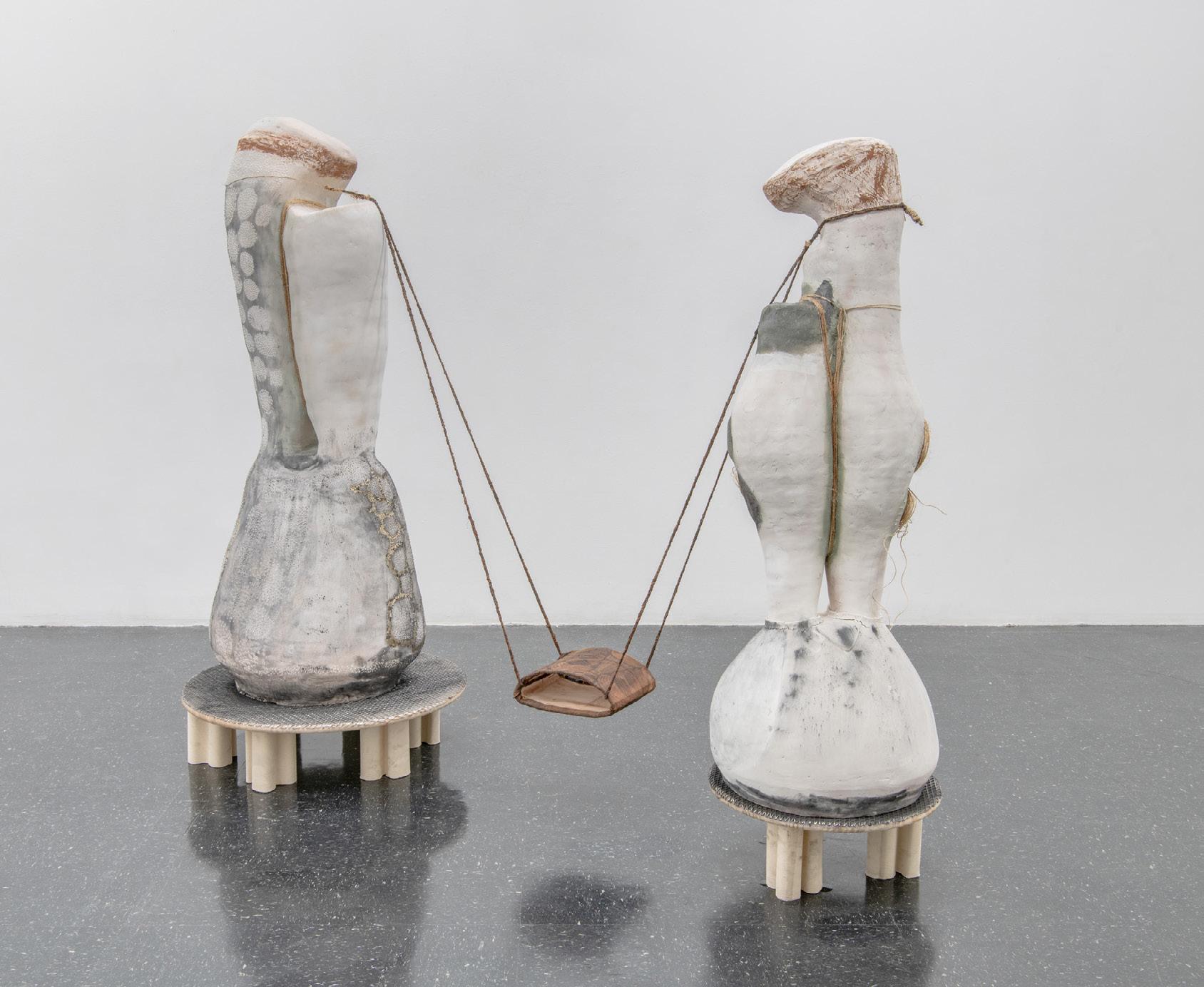
Installation View (p. 8-9)
Living Between Worlds/ Vesptures 1 (opposite, left)
Paper clay, red clay, sprayed colored slip, sprayed white slip, fabric, 3d printed ceramic seat, wood, metal, graphite powder 3d printed ceramic leg supports, slip detailing 79" x 48" x 24"
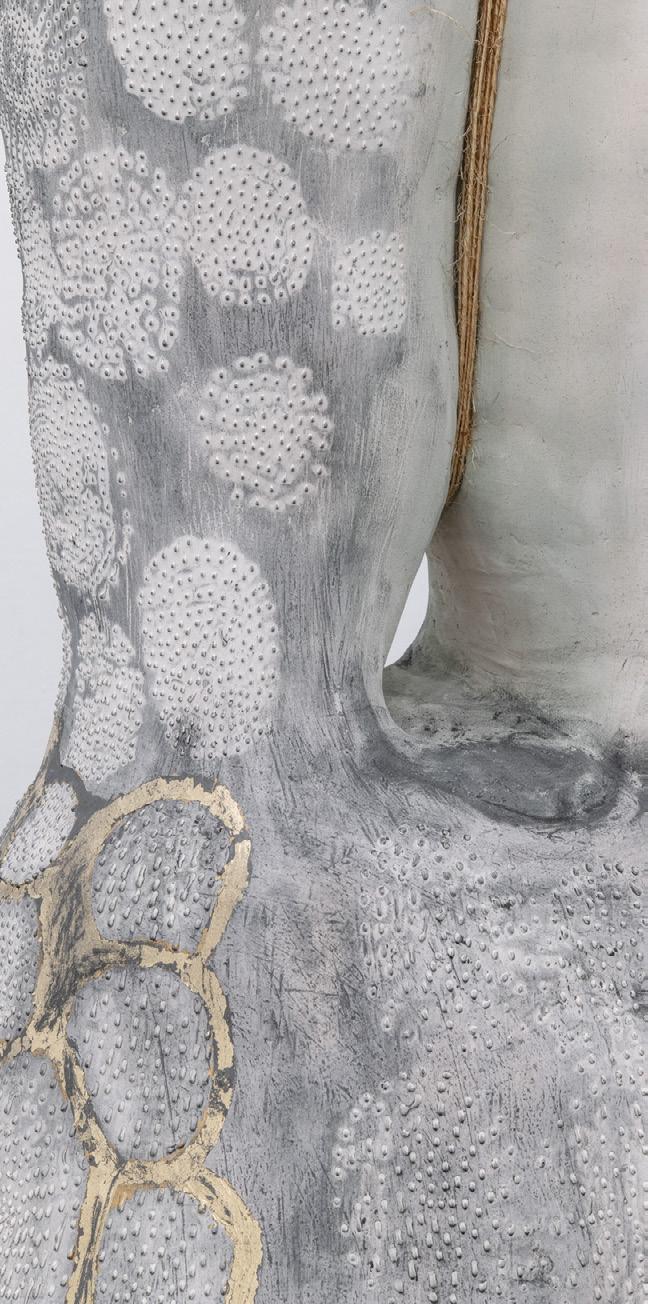
Mapping New Paths (below)
3d printed clay, smoke 72" x 120"



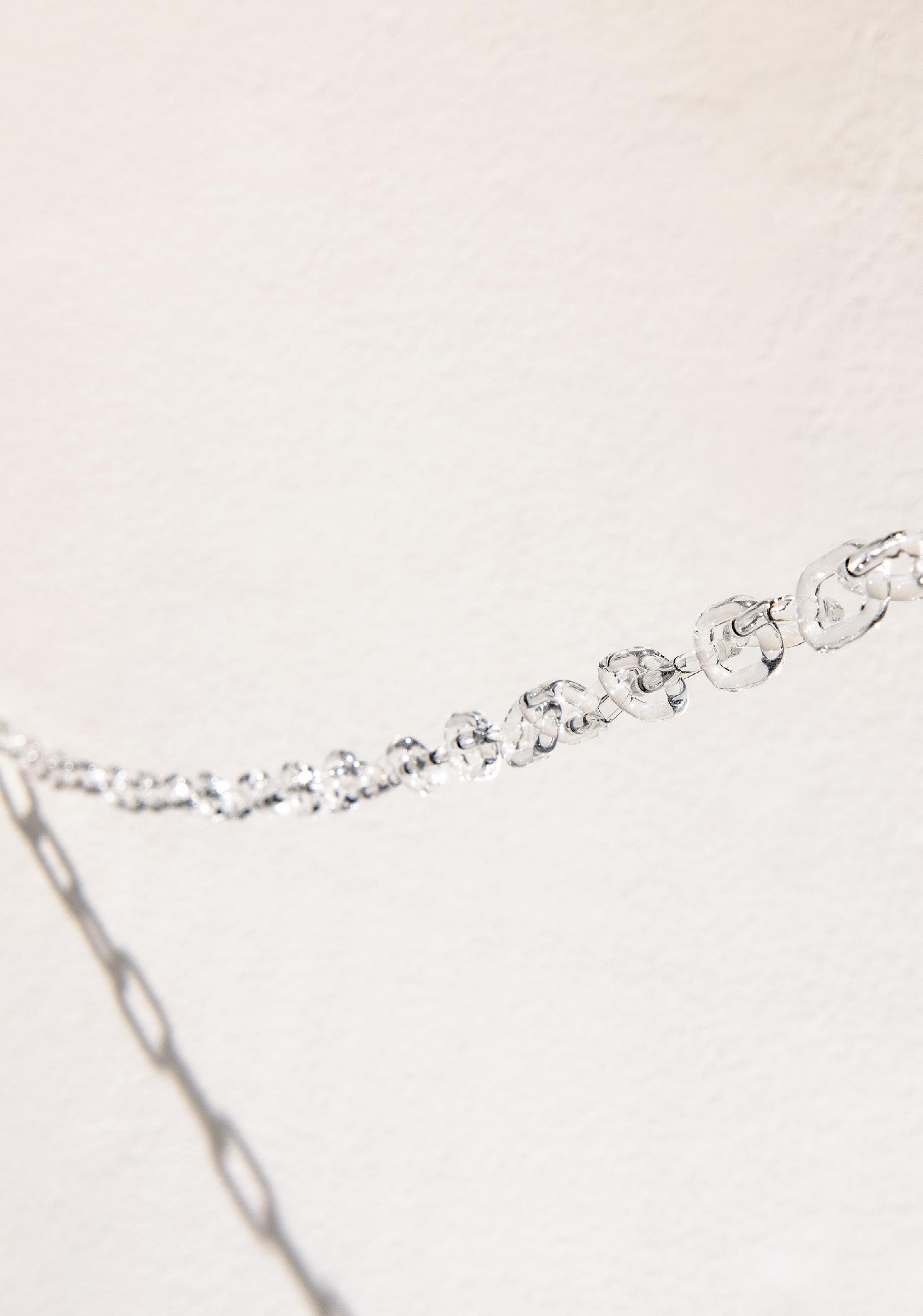 Kate Crankshaw
Kate Crankshaw
My work explores themes of memory, relationships, loss, grief and longing. I grew up living in constant transience, attempting to avoid formal foster care placement. Coming into adulthood made me question my upbringing and its effect on my adult persona. Since entering therapy to process my past, I have been diagnosed with multiple mental illnesses and gained insight into how these illnesses affect me daily.
My work utilizes glass to evoke the fragile nature of stability and the ghost-like quality of memory. I am interested in the dichotomy of having the desire for the stability that I lacked growing up, while simultaneously seeking out the continuation of the uncertainty that became so familiar. Trauma can affect the brain by leaving a haze over your past, leaving holes in what you remember. This project has empowered me to take back an element of control by processing my memories, and therefore, gaining a better understanding of myself. Through the repetitive process of making glass chain, my body is able to relax into a meditative state, allowing my mind to process grief and trauma. By finding peace in my past, I am able to achieve ataraxia and move forward.


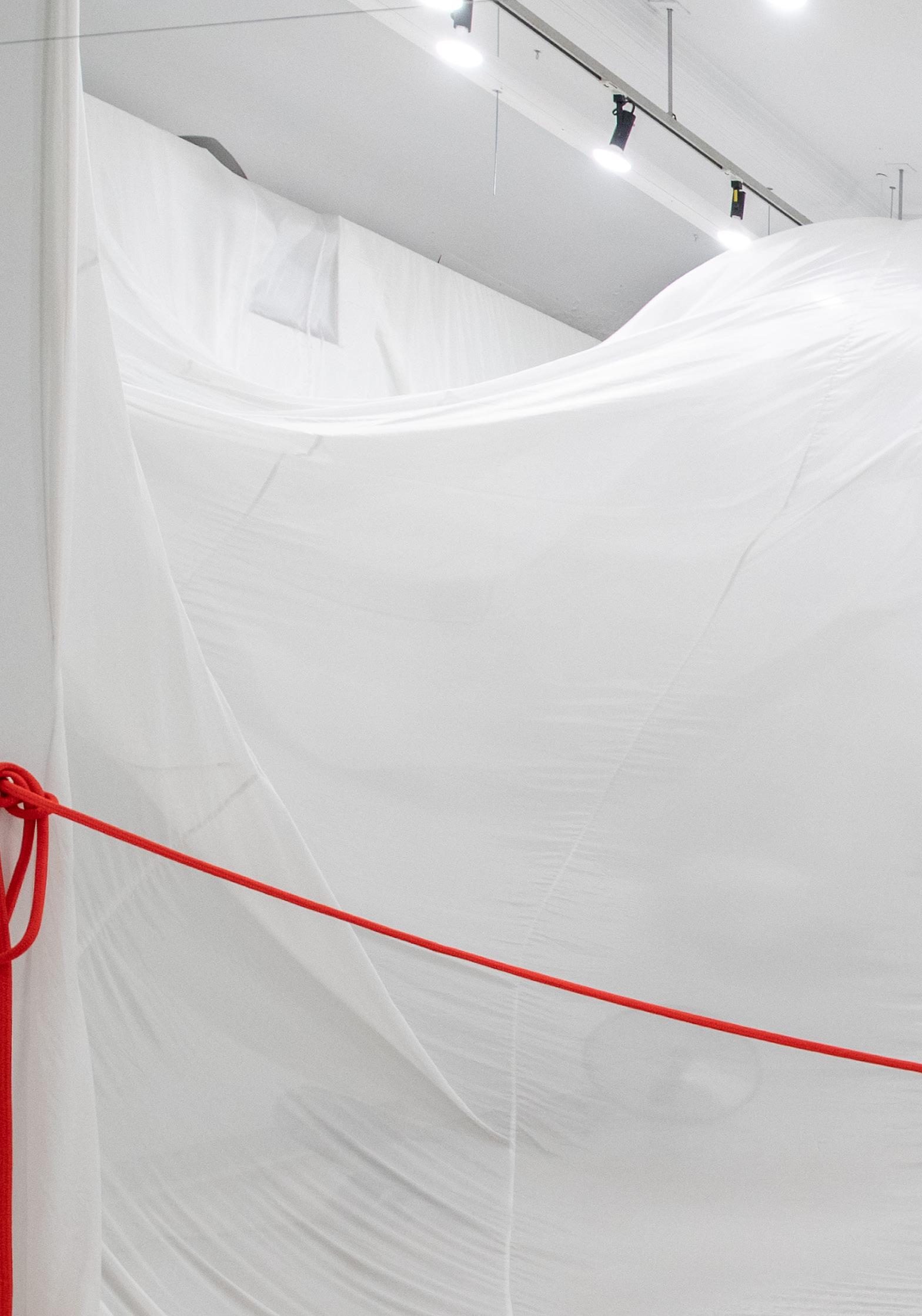


We breathe as a measure of time, it keeps us alive, and fabricates the pattern of our lives. We are punctuated by “snarls,” “glitches,” or moments of irregularity – of trying to catch one’s breath, having it taken away, or gasping for it. It is the punctuation of sighs, huffs, sniffs, scoffs, screams, and deep intakes that appear as glitches in the breathing system.
In our daily rhythm of breathing, the presence of the glitch, defined as potentiality, can create space for something unexpected or new to arise. Using the wind from fans and approximately 1,260 square feet of silk, this thesis explores the seen and unseen landscape in regard to different types of breath.
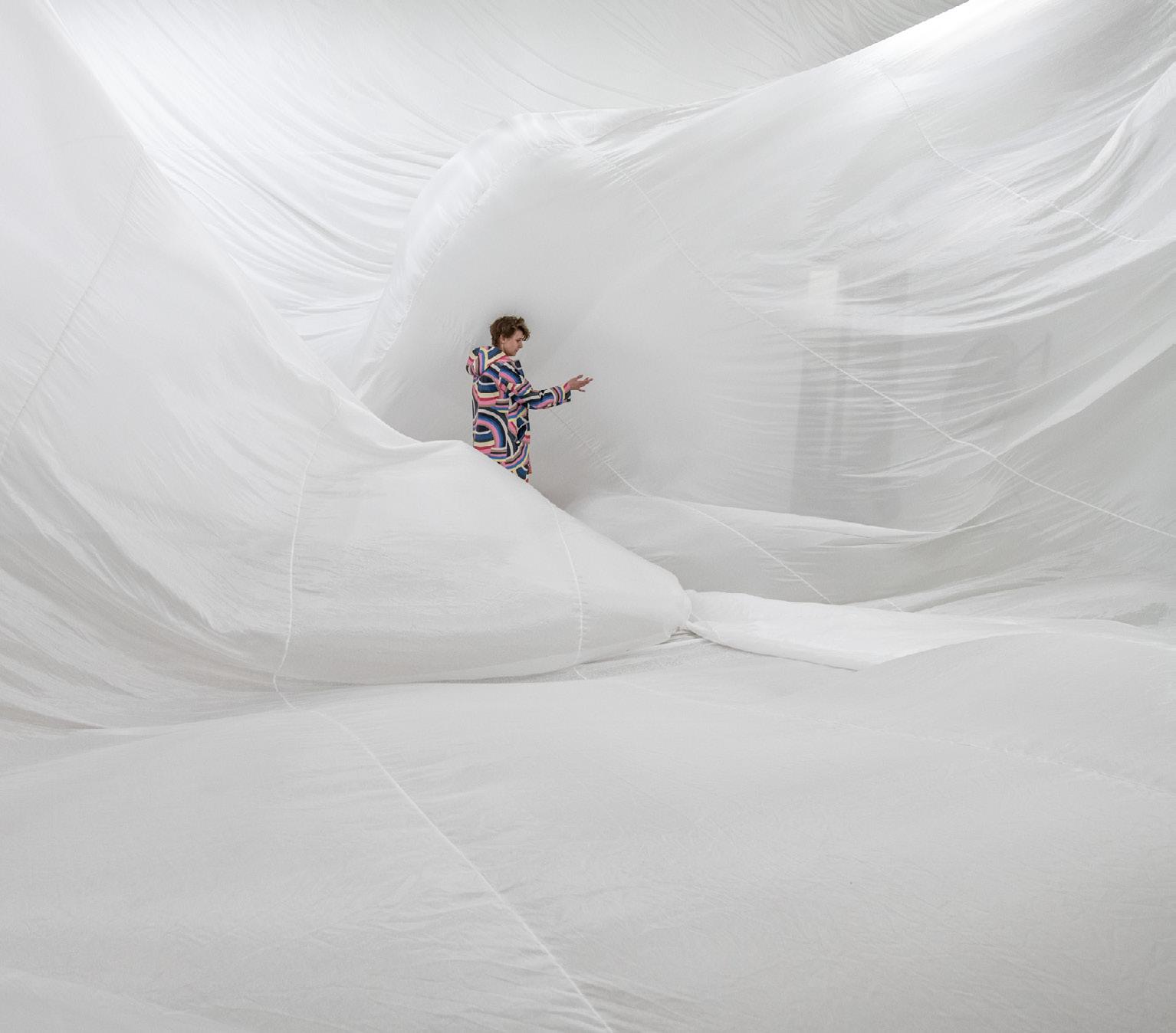
Metronome
Silk Habotai, fans 37' 9" x 21' x 14'
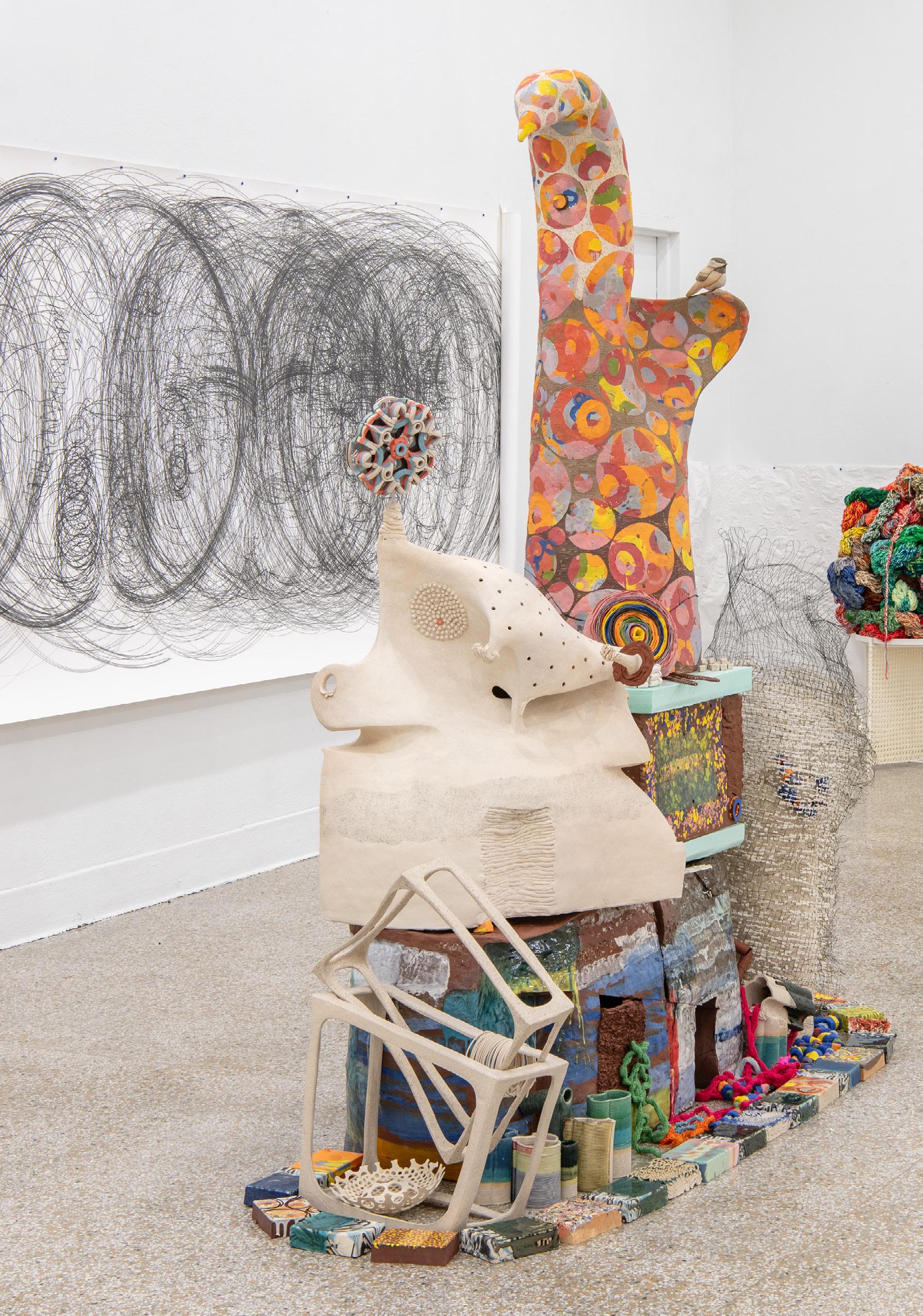
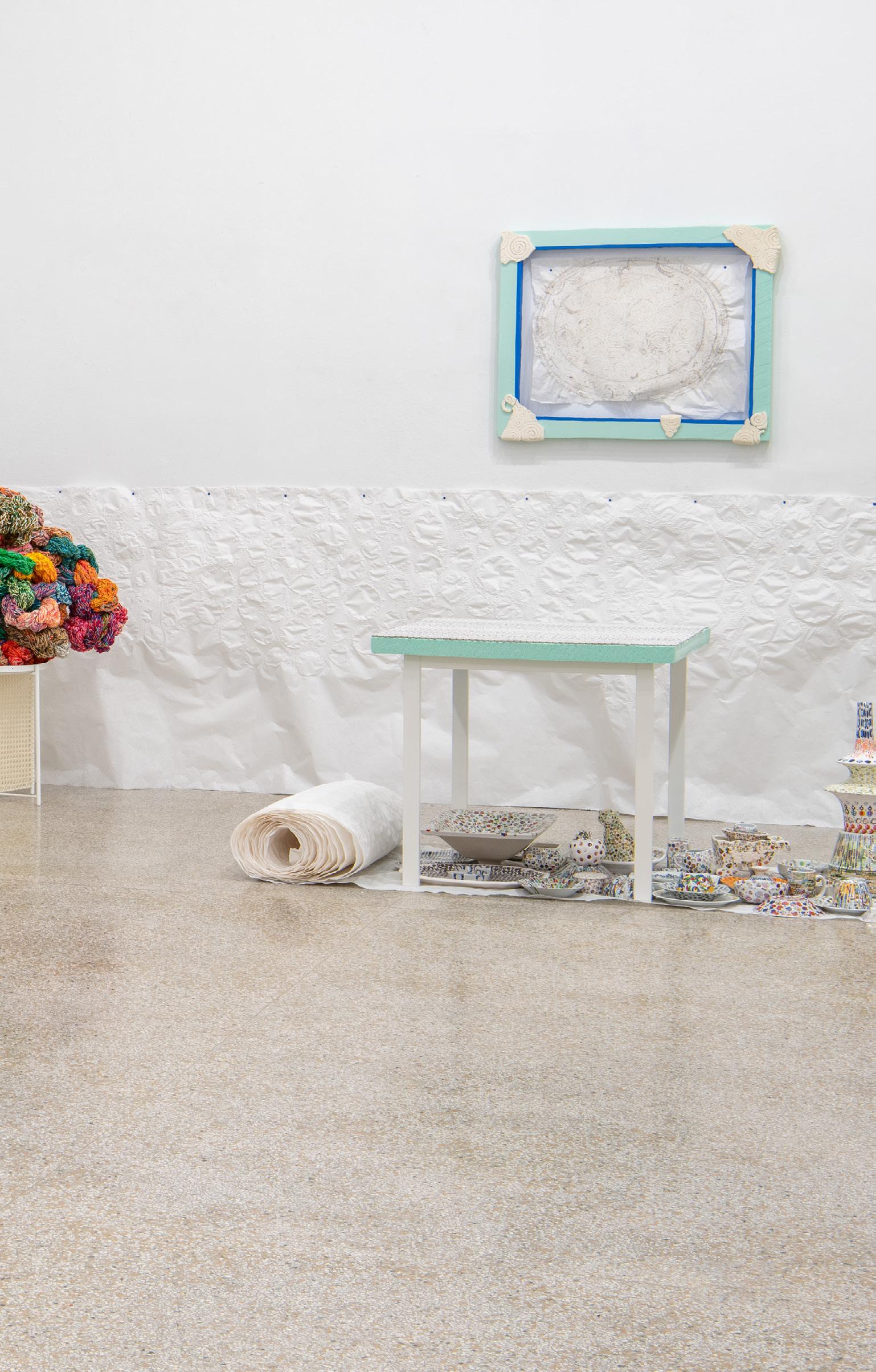
Welcome to the Sitting Garden at the Busy Hands Museum
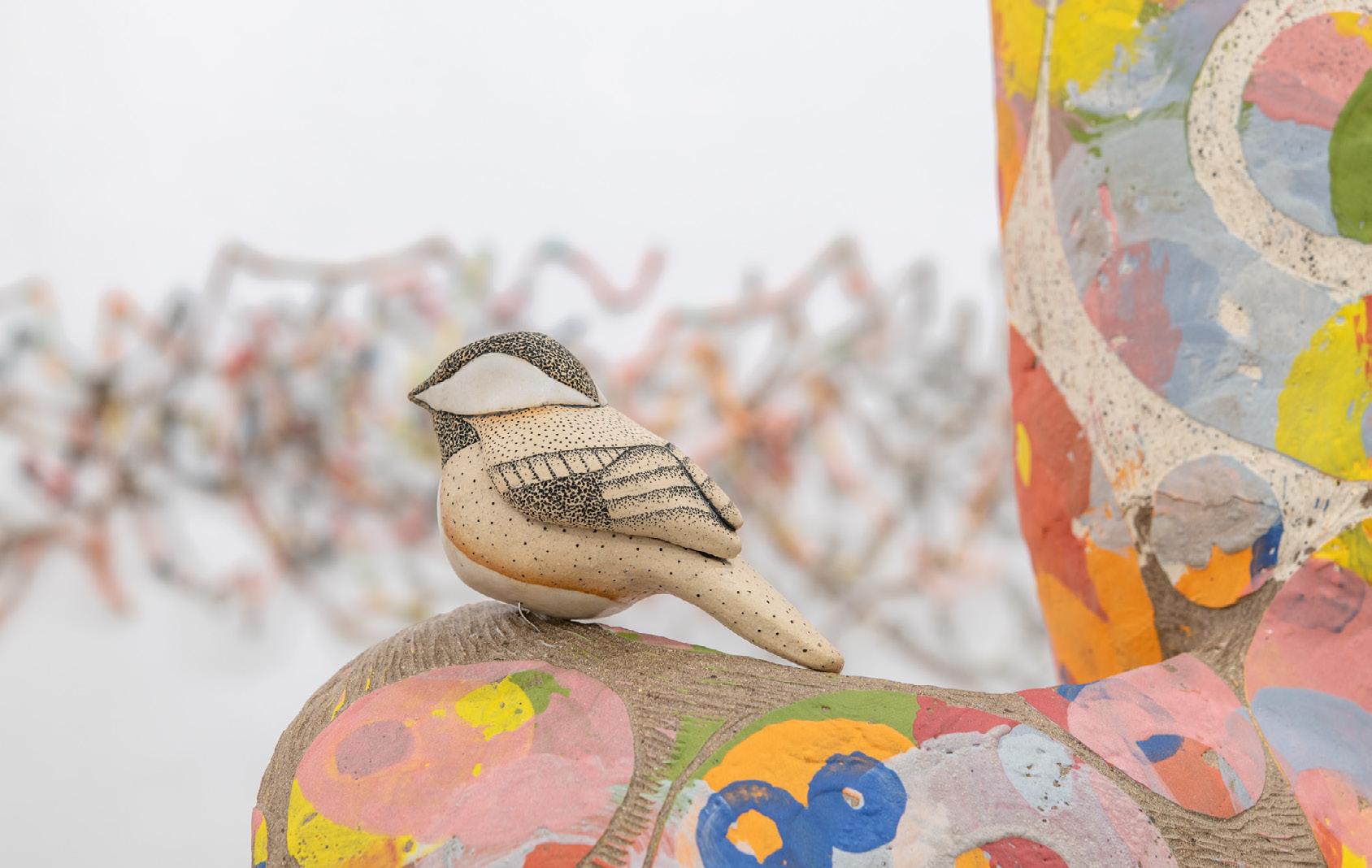

Mixed media
Variable dimensions
Welcome to the Sitting Garden at the Busy Hands Museum celebrates my love of color, material and process. This love often crosses into obsession wherein a healthy solace becomes incessant escapism, which can be detrimental. There are infinite ways in which obsession can manifest. Organizing, collecting, and creating often bog me down and keep me from engaging with the larger picture. To counteract this, I found ways to keep my body from spiraling into itself. Using full arm movements and graphite, I brought physical awareness into my practice (process). Creating
a place to sit is both an invitation to others and a reminder to myself to stop and take a rest from time to time (product). Recognizing that the remnant from a piece may be more surprising than the piece itself brought an energizing sense of magic into my studio (process and product). Working on multiple pieces at once—some that are more time intensive than others—kept me from putting too much focus on one method thereby increasing a healthy balance. I embrace my obsessions. I do not want them to embrace me.


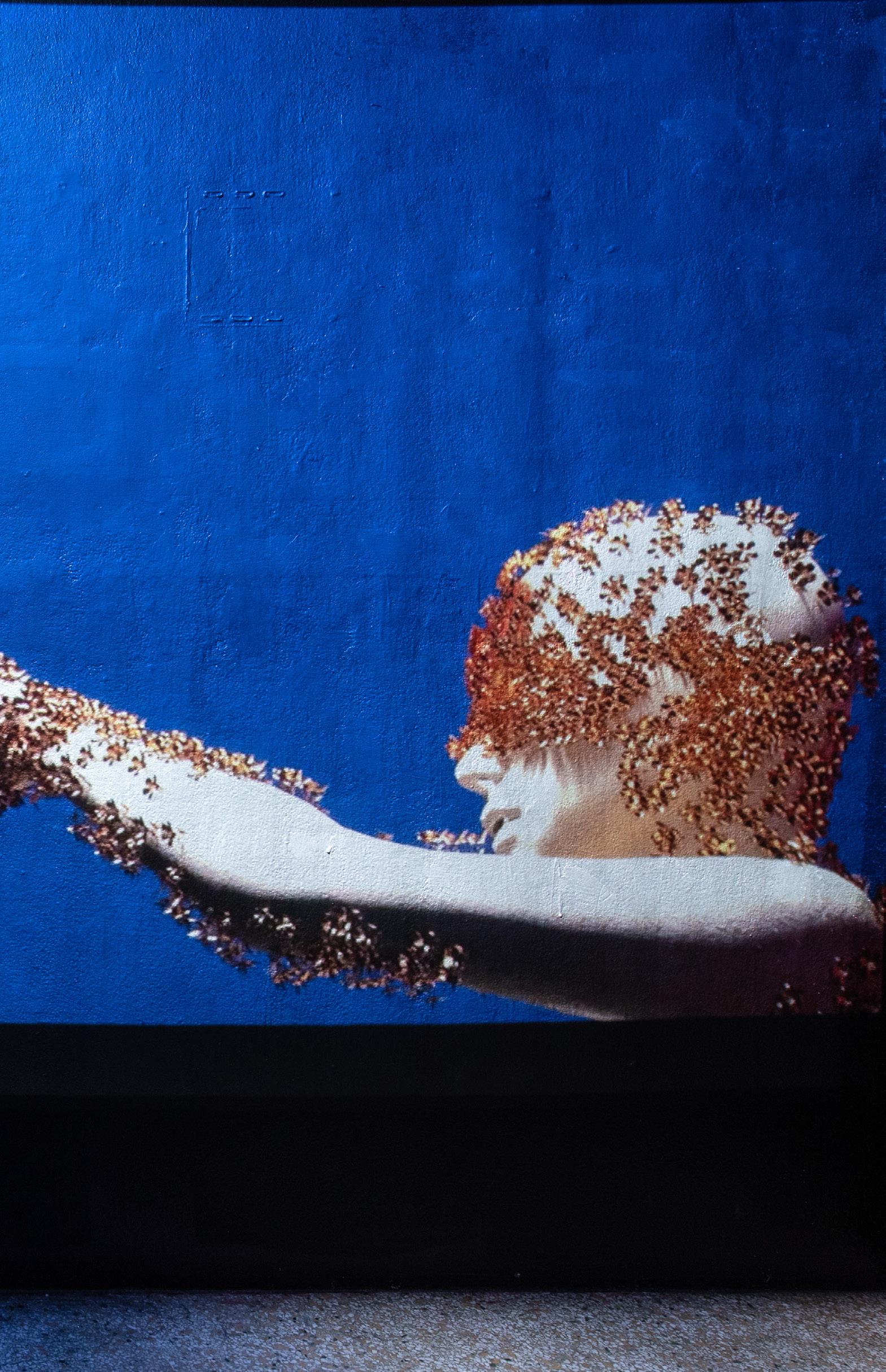
Yameng Wang
—TO二TO三 is a 3D film about iteration and simulacrum. It is like some unexplained scattered light on a piece of paper. The object of these diffractions is the generalized artificial intelligence (AI) generation program. My imagination is the narrow hole the light passes through.

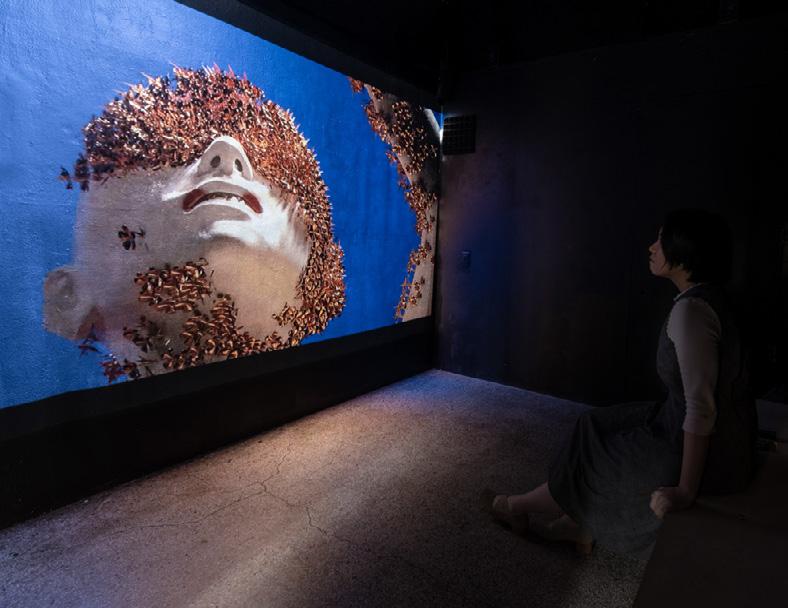
 —TO二TO三 Video
—TO二TO三 Video





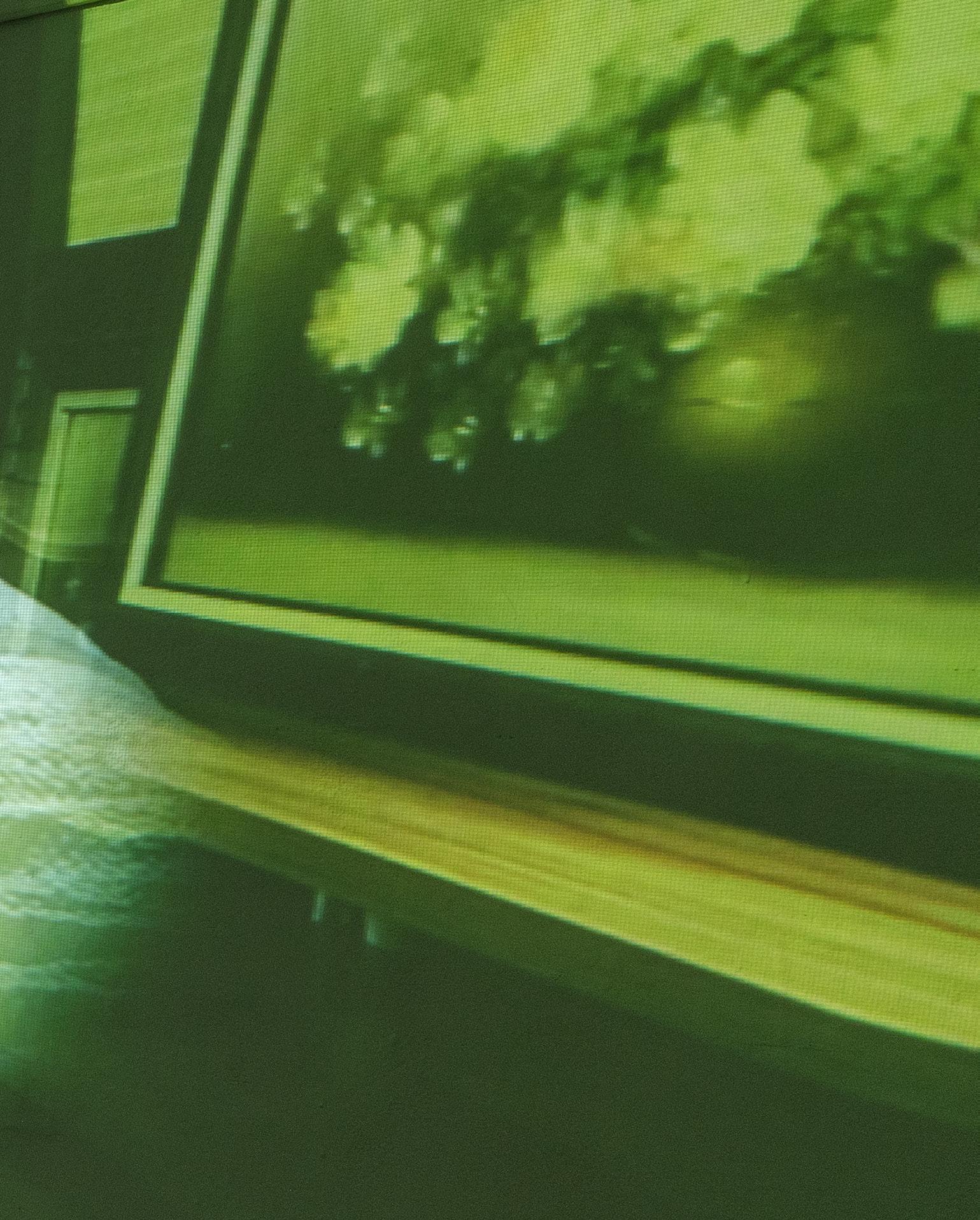
Lindsey Arturo
Who is Irene Cox? A virtual quest looking for answers in all the wrong places.
Thirteen original paintings of the same flowers and all signed by Irene Cox asks the viewer to look, see, and observe these images of flowers through a kaleidoscope of visual techniques.

Irene Cox Videos (p. 28-29 and above) Three channel, highdefinition video, Super 8 15:06 min loop

Irene Cox Paintings (opposite top)
Thirteen found paintings, cardboard boxes, greenscreen wall Variable dimensions
Irene Cox VR Room (opposite) Virtual Reality Goggles


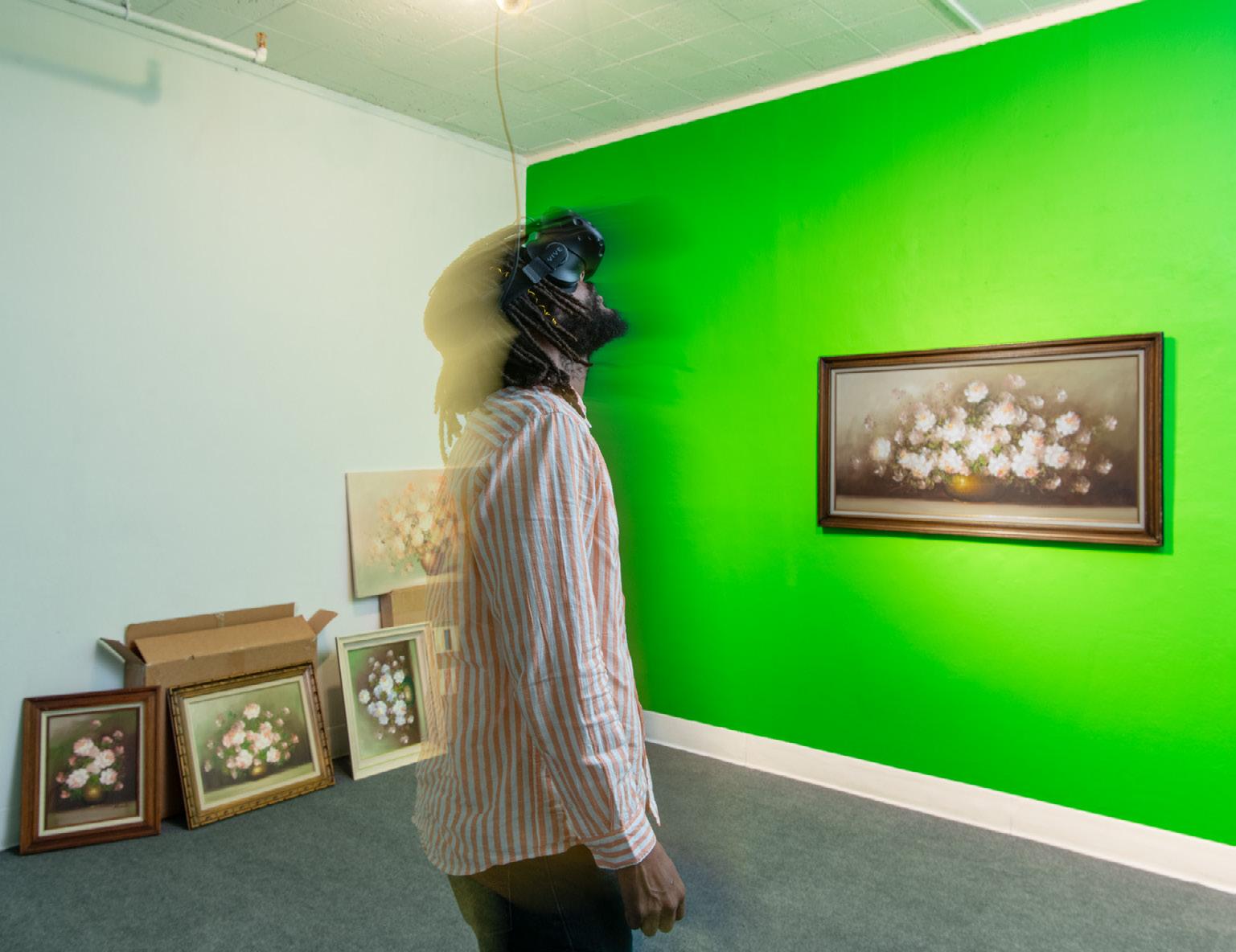
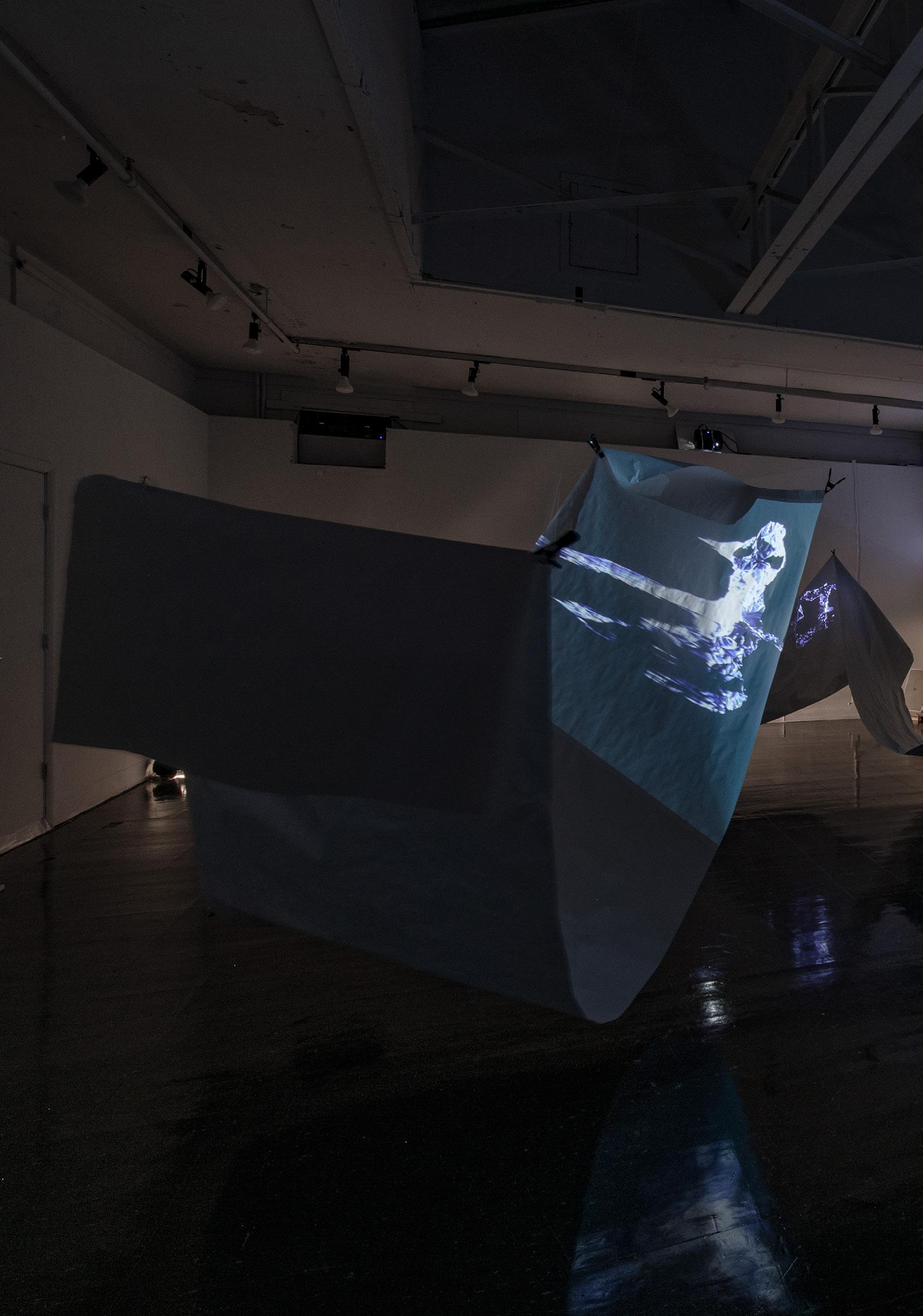
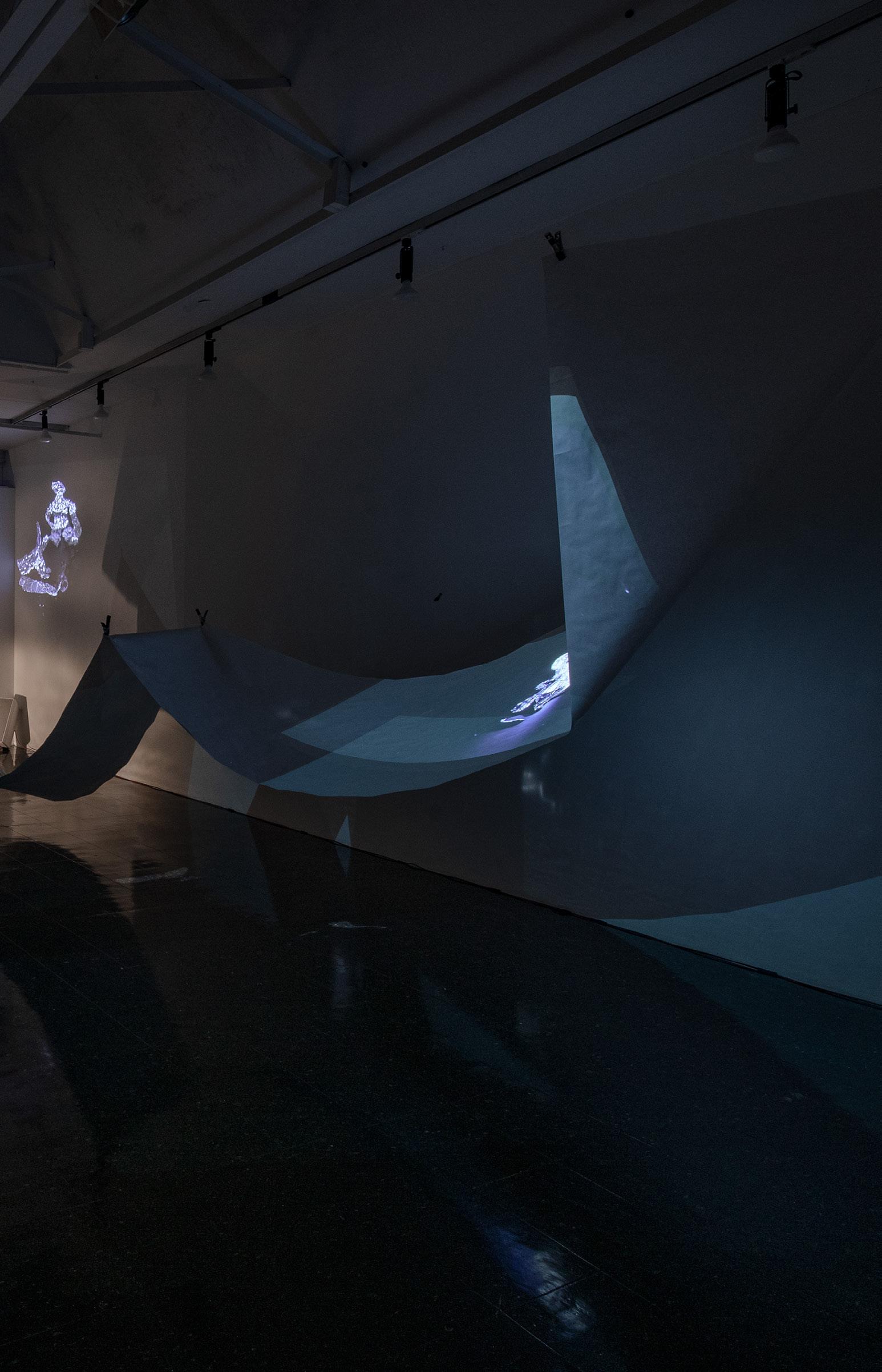
dimensions
Kaitlyn Paston
come as you are, expanded is an extension of my research on the slippery relationship between body and image and material. The aluminum foil figures are reflective, pliable, sensitive, fragile, yet have an integrity and can hold themselves up. Like bodies, their material has limitations and proclivities. Like images, they
are flat. Becoming a feeling, empowered body happens again and again since human bodies are cyclical systems. This repetition is reflected in the animation process. Each gesture is a repetition of touch between the animator and the figure. The viewer’s experience of sequence depends on how they move through the space.
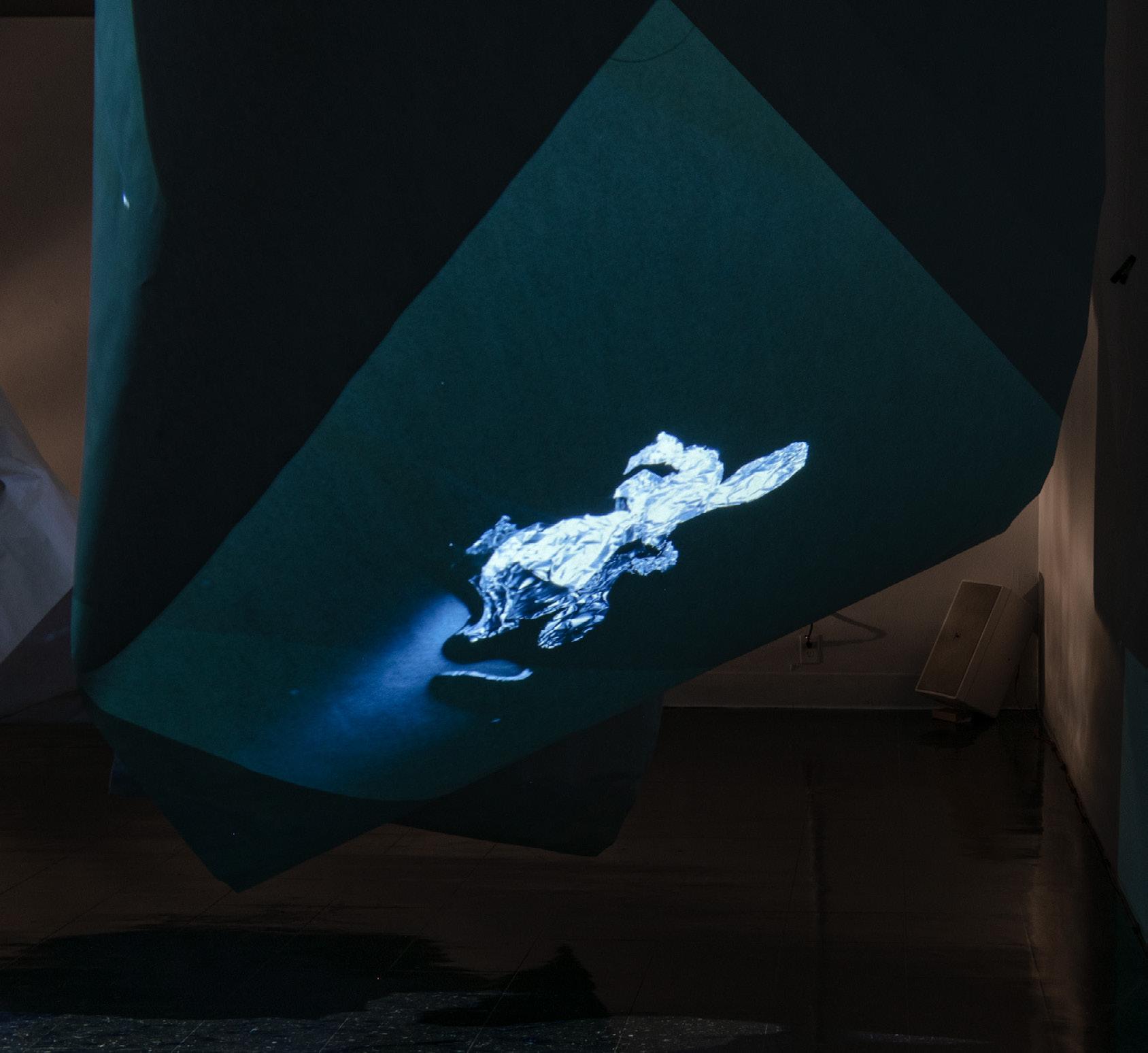 come as you are, expanded Multi-channel projection on paper, sound Variable
come as you are, expanded Multi-channel projection on paper, sound Variable
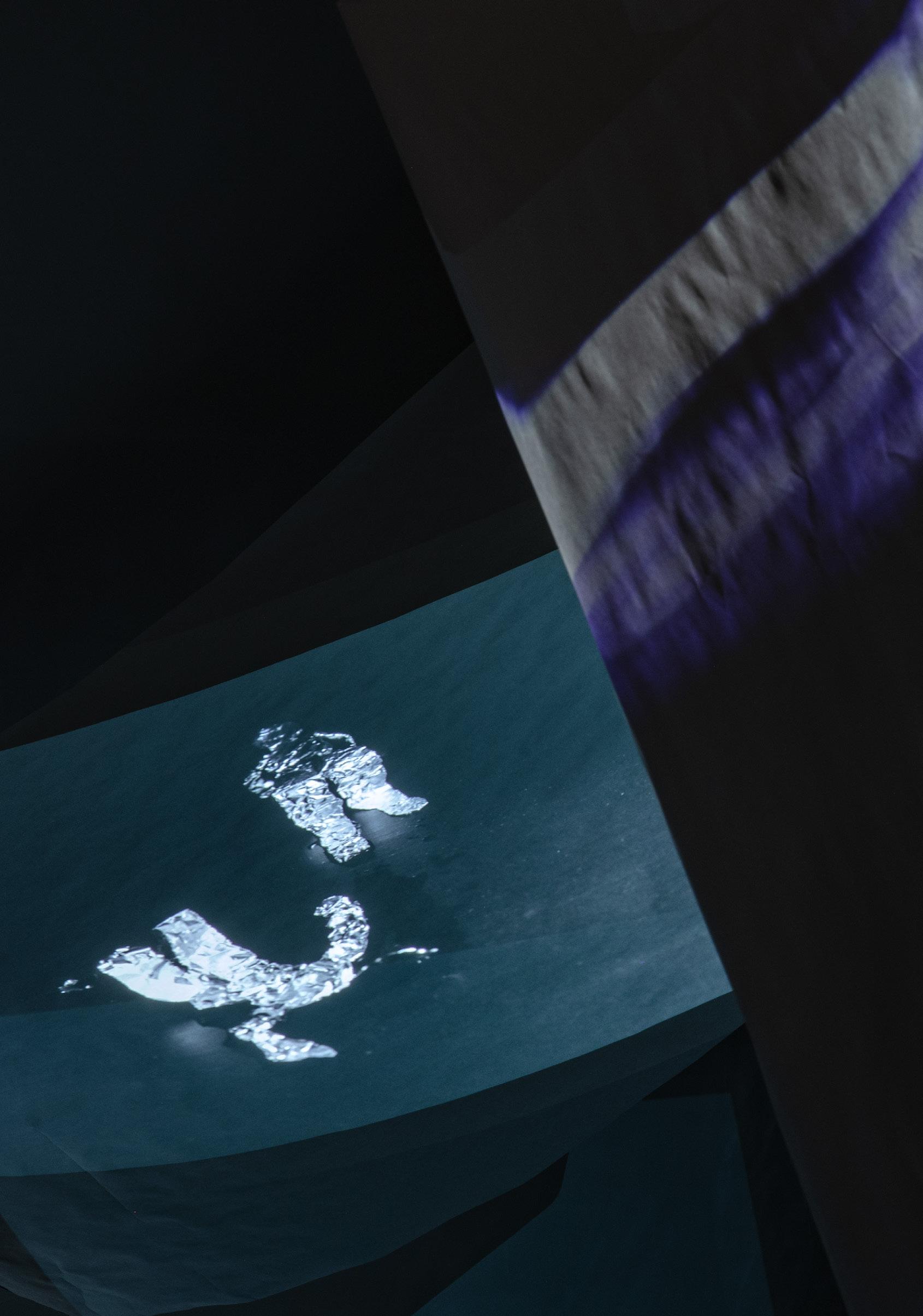

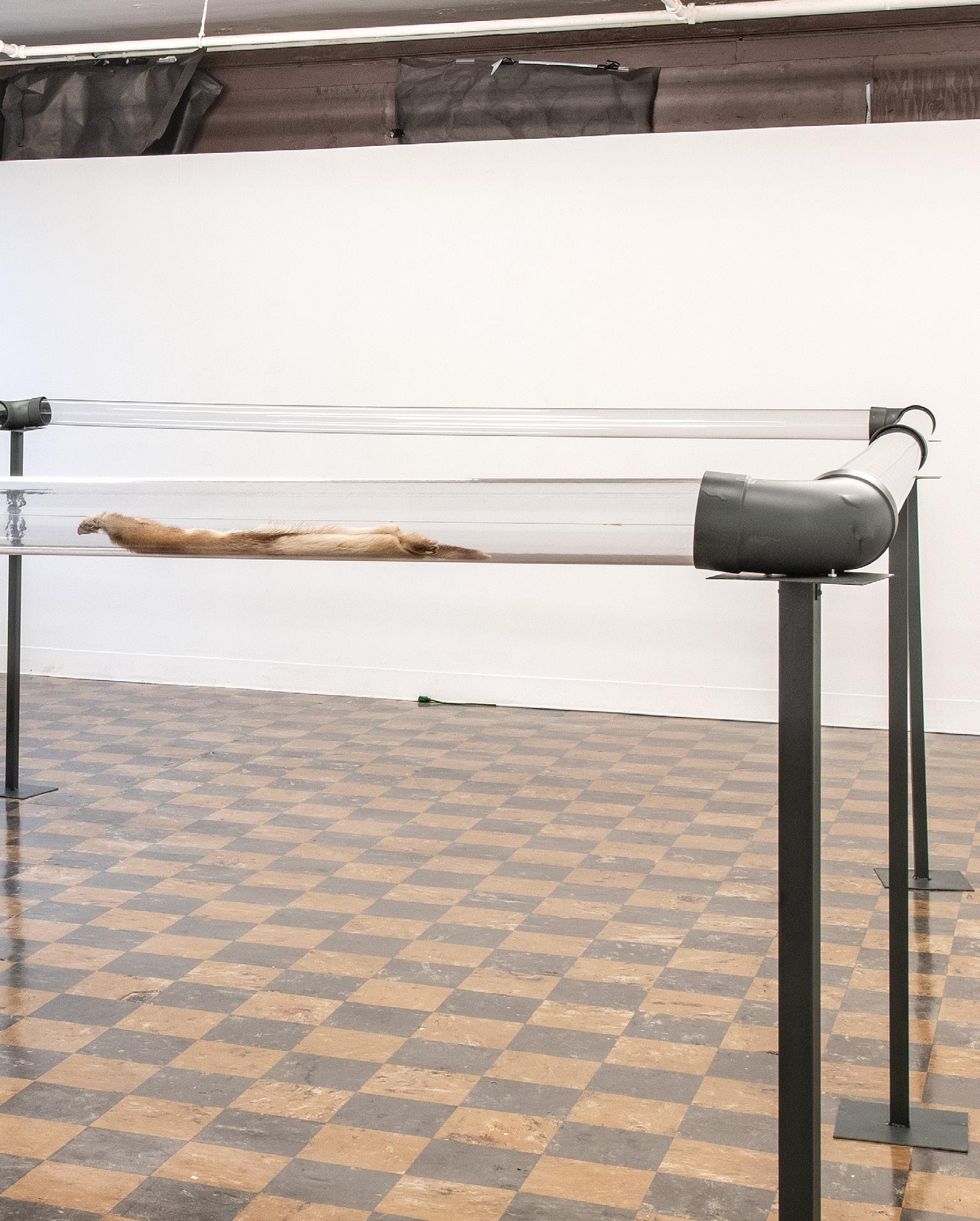
Samson Stilwell
Win Conditioned is an exhibition concerned with what philosopher Byung-Chul Han has called “the achievement-subject.” In The Agony of Eros (2012), Han describes the narcissistic, depressive, self-oppressive subjects of contemporary capitalism as no longer subjects but “projects” to be constantly refashioned and reinvented. The “achievement-subject” is wrought by an excess of positivity because, “today, negativity is disappearing everywhere. Everything is being flattened out into an object of consumption.” For Byung-Chul Han, this flattened world of positivity creates an “inferno of the same”: a never-ending present, an endless work week, a logistics of everaccelerating deliveries, remakes and sequels.
Whee! Like An Arrow, the kinetic sculpture at the center of the exhibition, is designed
around a lure coursing machine. A lure coursing machine is the type of machine used to race dogs by dragging a lure, in this case the pelt of a ferret, at high speed in a loop. In Whee! Like An Arrow the lure courser has been designed to operate at human eye-level, suspended by, as well as protected and displayed within, sixty feet of clear acrylic tubing.

Win Conditioned presents a crucial crux of life within the inferno of the same: We are entranced by the impossible spectacle of our lives–our speed and intensity and color–and we are depressed–unable to work towards anything other than winning at our own individual goals, unable to live any time but the eternal present.
Byung-Chul Han, Agony of Eros, Cambridge, MA: MIT Press, 2017
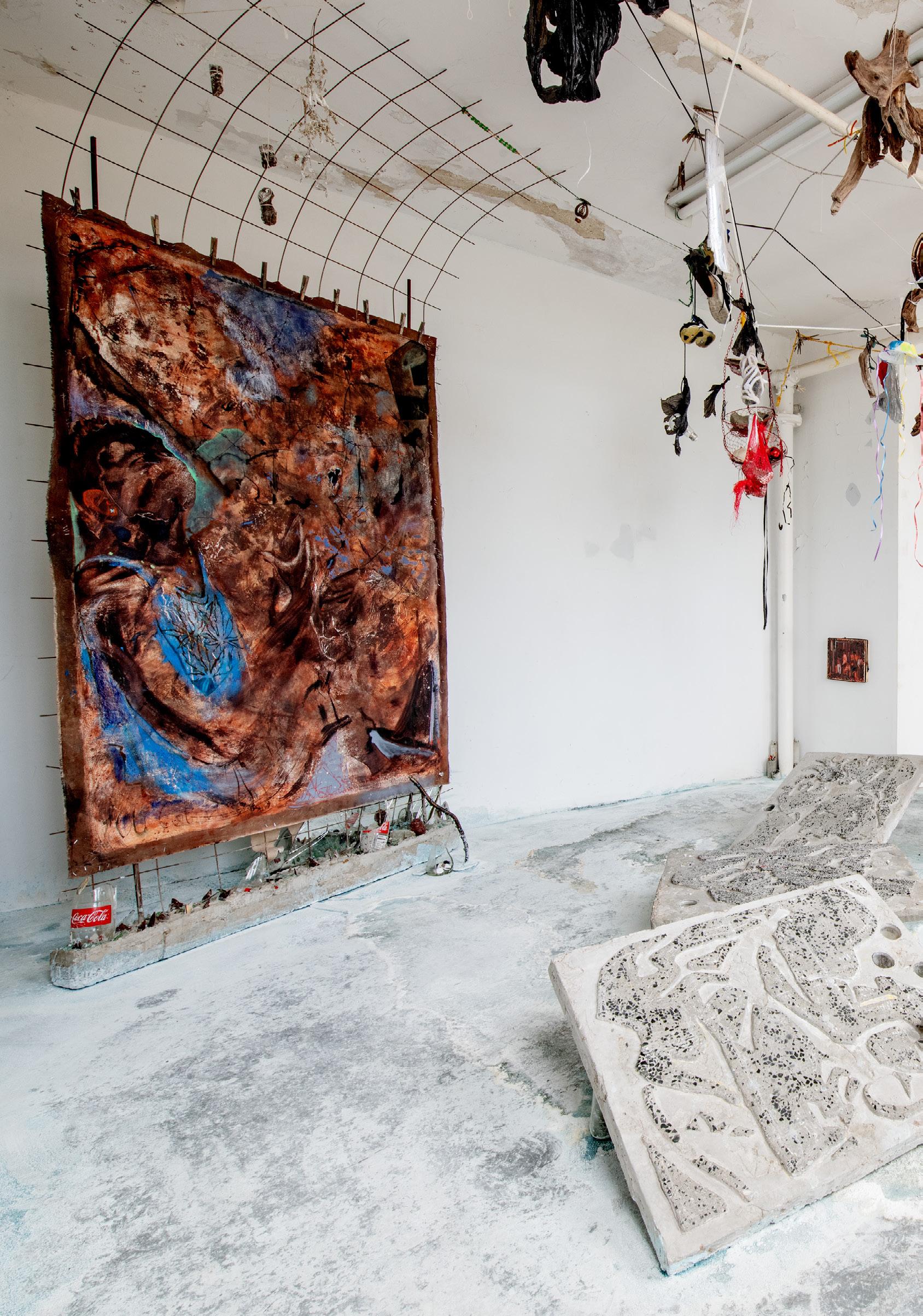
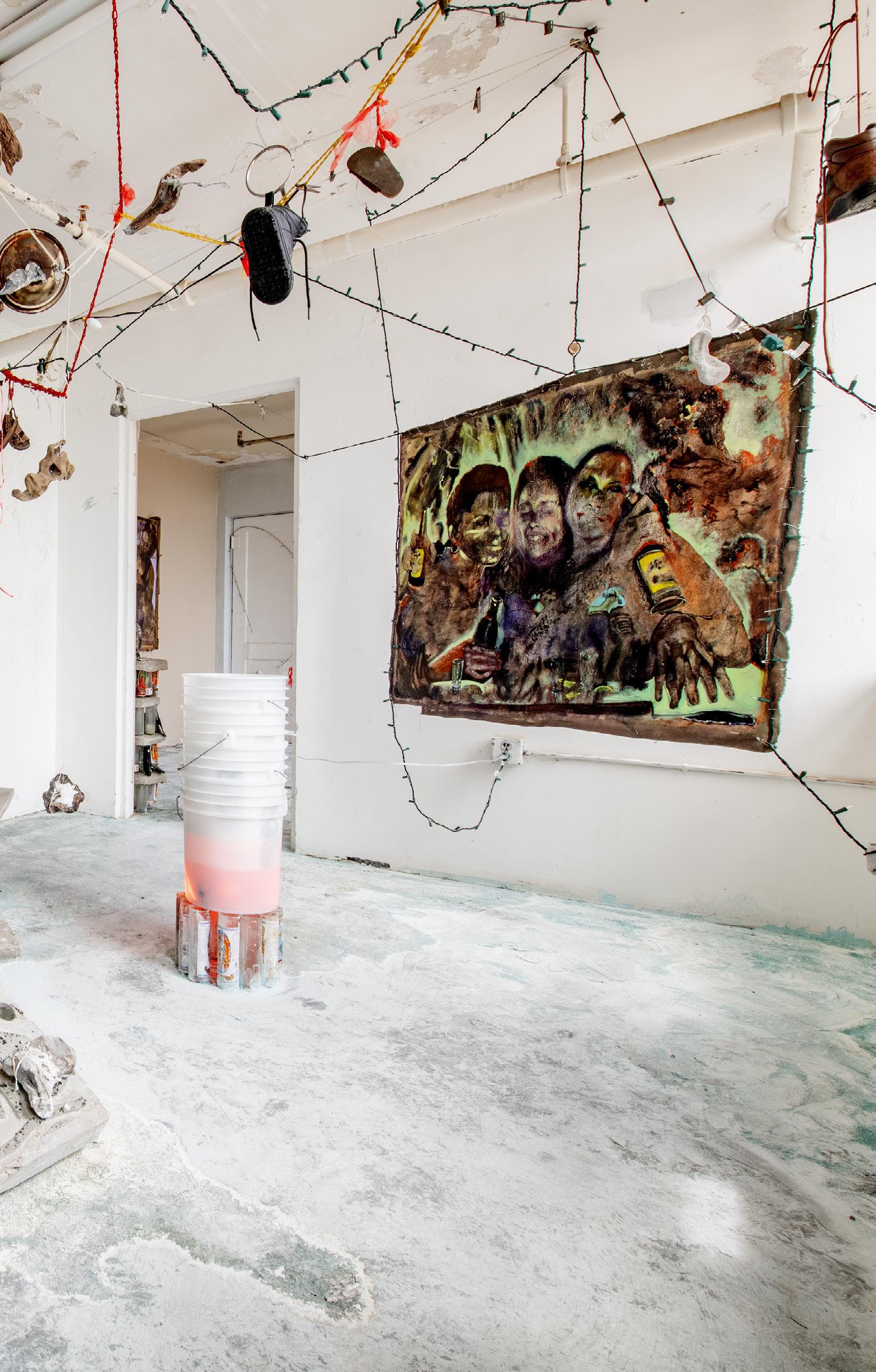
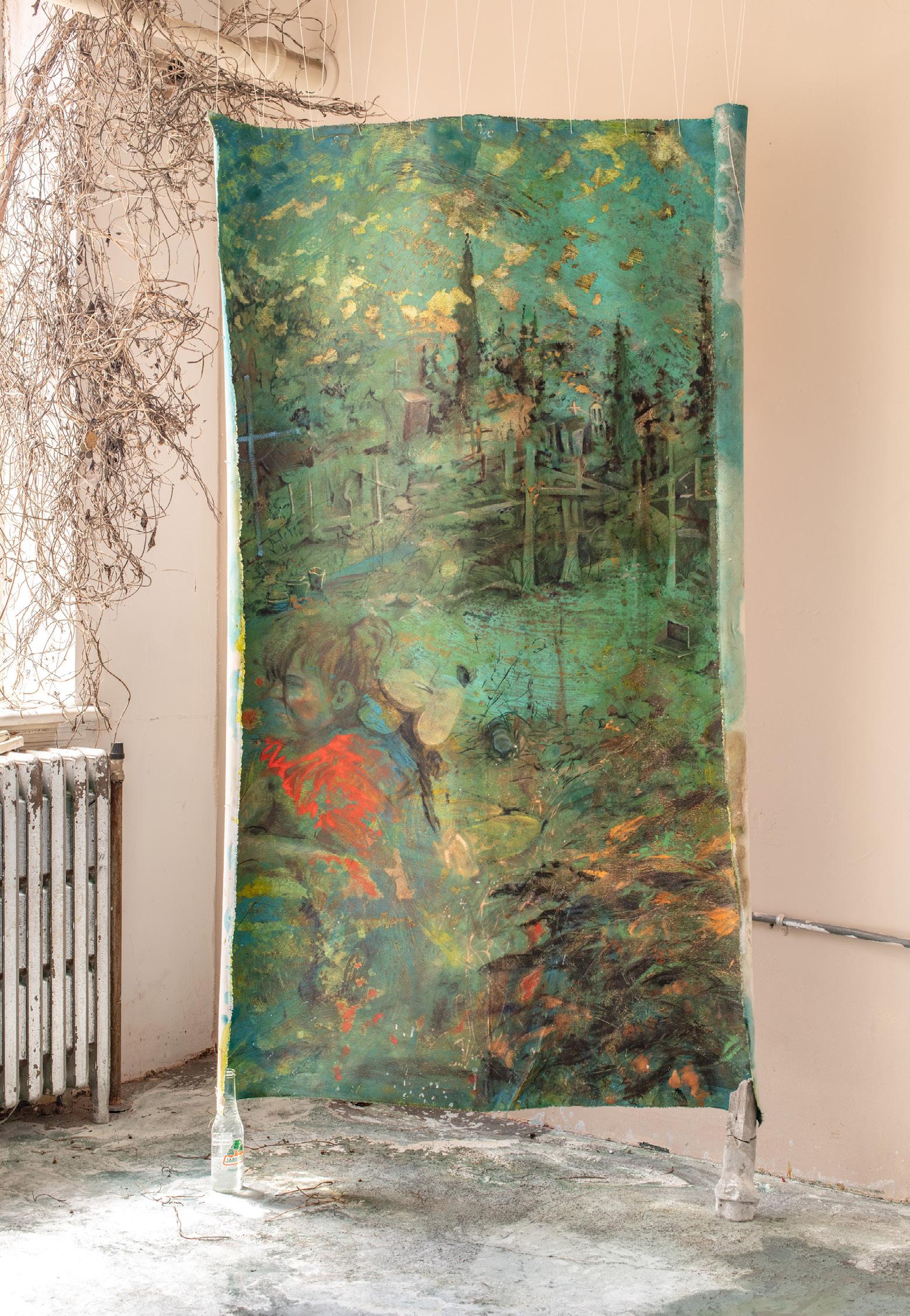
You burned small holes into the linear flow of time like extra smoke breaks and eddies in the water and left me snarling stories into votive objects. I start with scraps of memory, handled often and reworked. These wear thin at the edges and are burnished, repainted in brighter, unsettling colors. They calcify, grow brittle and break. I mend them at the seams. The result isn’t really a memorial to a certain person or event but a talisman with its own weight and significance.
duende (opposite)
Oil, acrylic, and soap on unstretched canvas, dead morning glory vines, white string
74" x 47"

every song i know (top)
Oil acrylic and soap on unstretched canvas over panel, fragmented cardboard shadow box
40" x 48"


 Vale and Benny (p. 44-45)
Oil on canvas
48" x 60"
Kiss (above)
Oil on canvas
32" x 28"
Mommy (opposite) Oil on canvas
52.5" x 42"
Ilana Dodelson
Vale and Benny (p. 44-45)
Oil on canvas
48" x 60"
Kiss (above)
Oil on canvas
32" x 28"
Mommy (opposite) Oil on canvas
52.5" x 42"
Ilana Dodelson
This body of work represents the experience of existing in multiple spaces at once. Through an iterative process of image-making, these paintings explore both the beauty and vertigo inherent in such an experience.

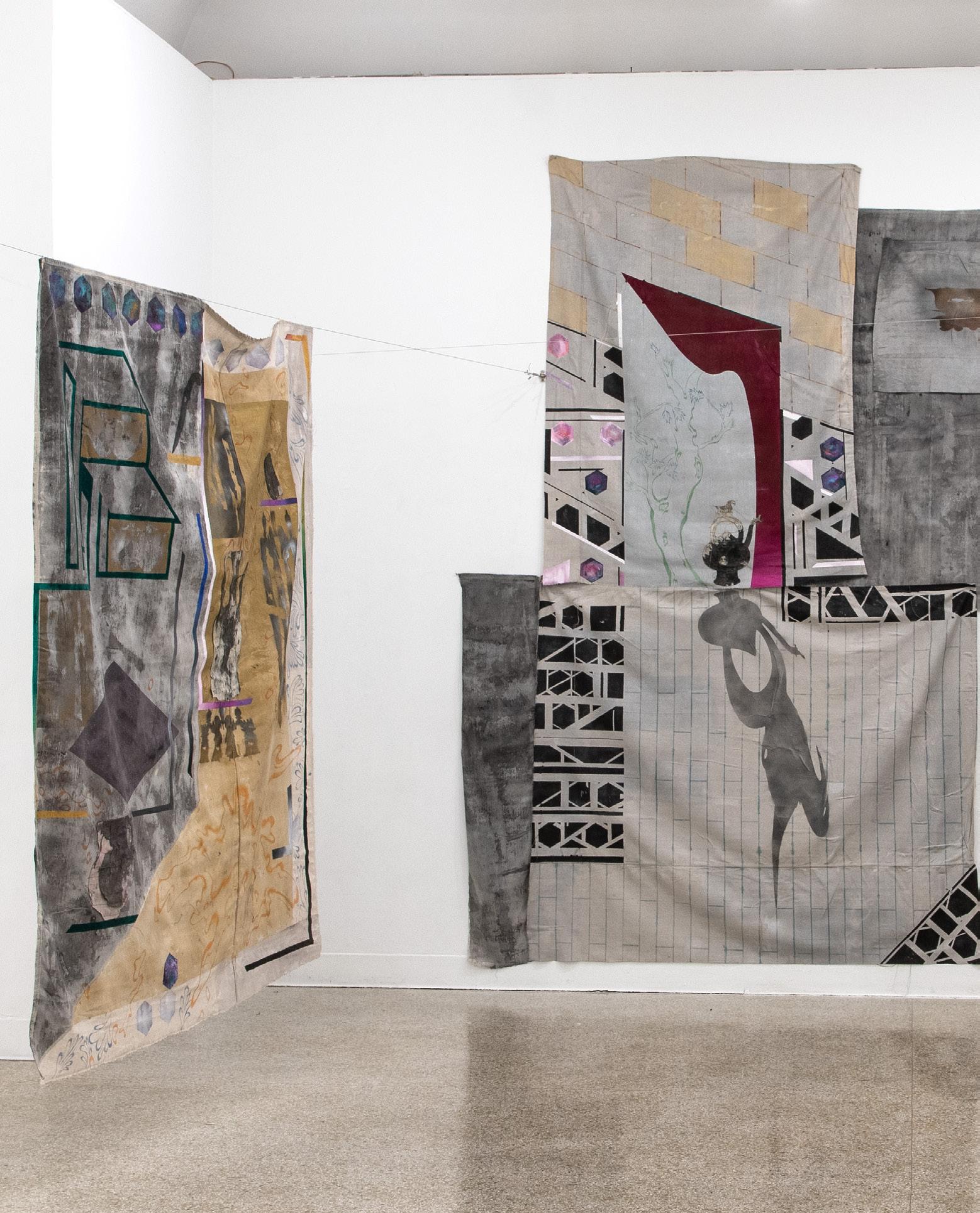
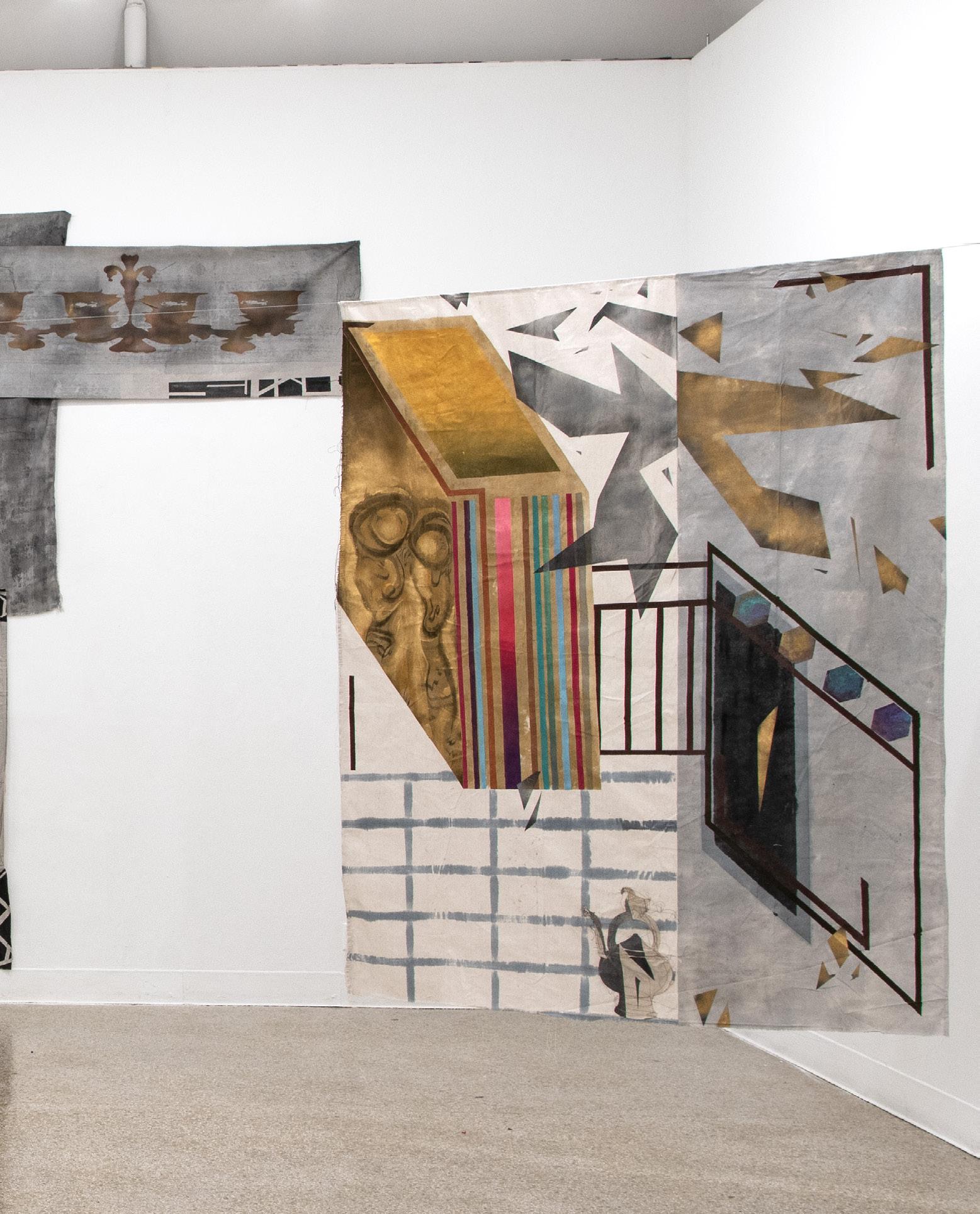
Untitled 2 (below)
Untitled 1 (opposite left
Untitled 3 (opposite right Natural dyes, industrial dyes, acrylic, spray paint, cement tape, and fabric collage on raw canvas 90" x 72"
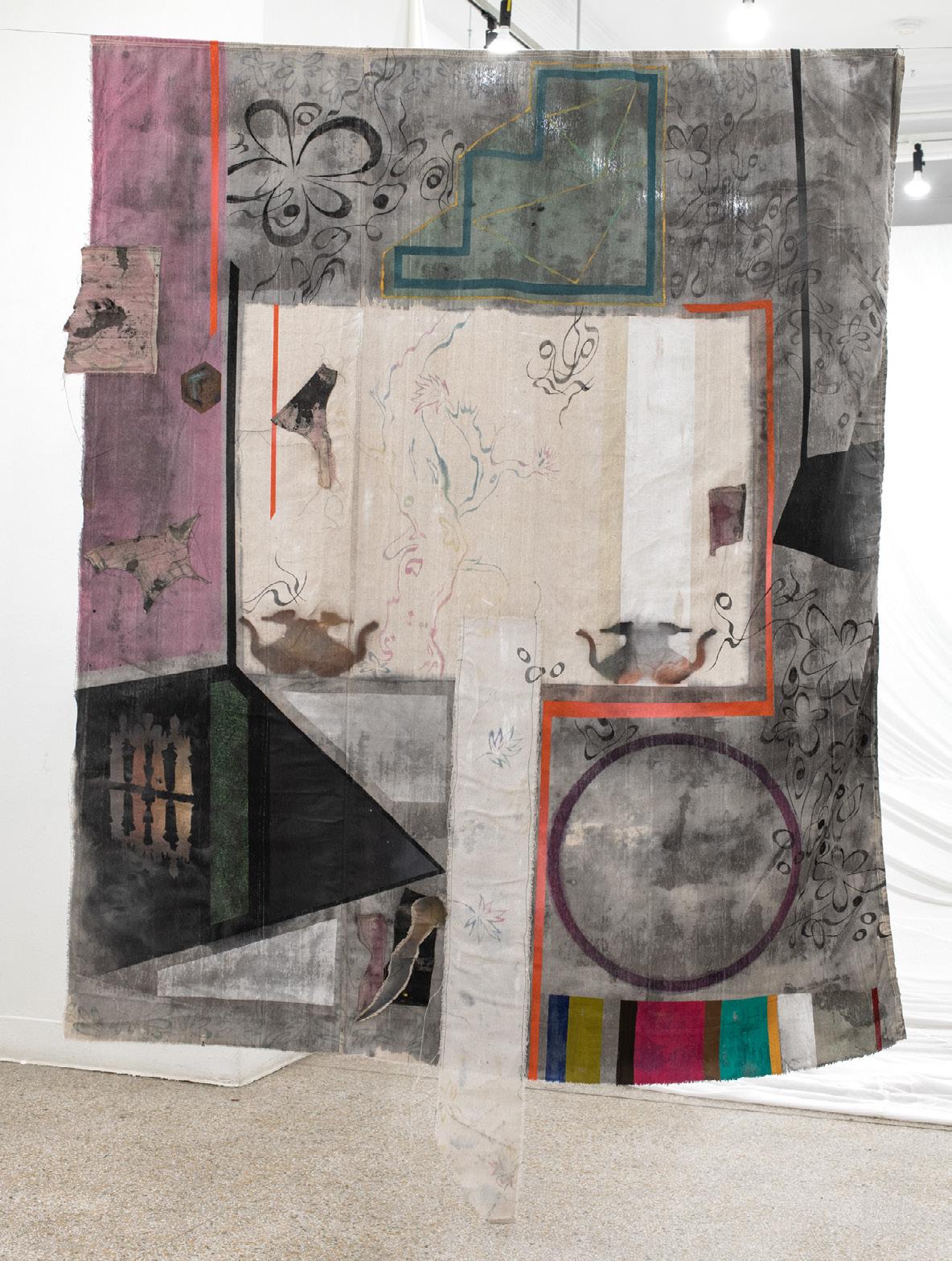 Installation view (p. 48–49)
Ali Kaeini
Installation view (p. 48–49)
Ali Kaeini
My recent body of work borrows from Iranian history, art and architecture, decorative arts, and crafts as an allegory for the displacement experienced by contemporary Iranians, both physically and mentally. My focus has been on materials and how they relate to each other. I recreate decorative elements, especially Persian vases, and ancient Persian and Islamic structures—thrones, walls, stairs, windows, and gates—through the use of homemade natural dyes, fabric dyes, cement tape, acrylic, spray paint, fabric collages, and printmaking. The geometric structures are surrounded by spiral organic forms and tablets reminiscent of ancient Persian and Arabic calligraphy. The contradictions of material and form arise from the complex relationship between my identity and culture.
The visual tension and the displacement of ancient Iranian relics and designs express my immigration story, which paradoxically is a mixture of belonging and non-belonging. The works reflect the feeling of a society


disillusioned with a 40-year-old revolution. Feelings that praise the rich cultural and artistic past while simultaneously fear of the deep gap between that beautiful past and the ugly present. Mirroring today’s Iranian protesters, hopeful about a vague future. Making engaging images from these materials and tools gives them a new life.
The vase imagery in my paintings is referenced from the Persian poet, astronomer, and mathematician Omar Khayyam’s writing. The vases, each different from the others and a symbol of human diversity, reference the stolen Persian ancient objects in museums worldwide. Vases and other museum objects such as scissors, daggers, decanters, and lanterns once had a living and functional identity but today have only a decorative and historical identity; therefore, the silhouettes of broken and dusty objects are a metaphor for the displaced body. As a result, the vases and other objects in my works are a symbol of human beings with an identity belonging to the past.
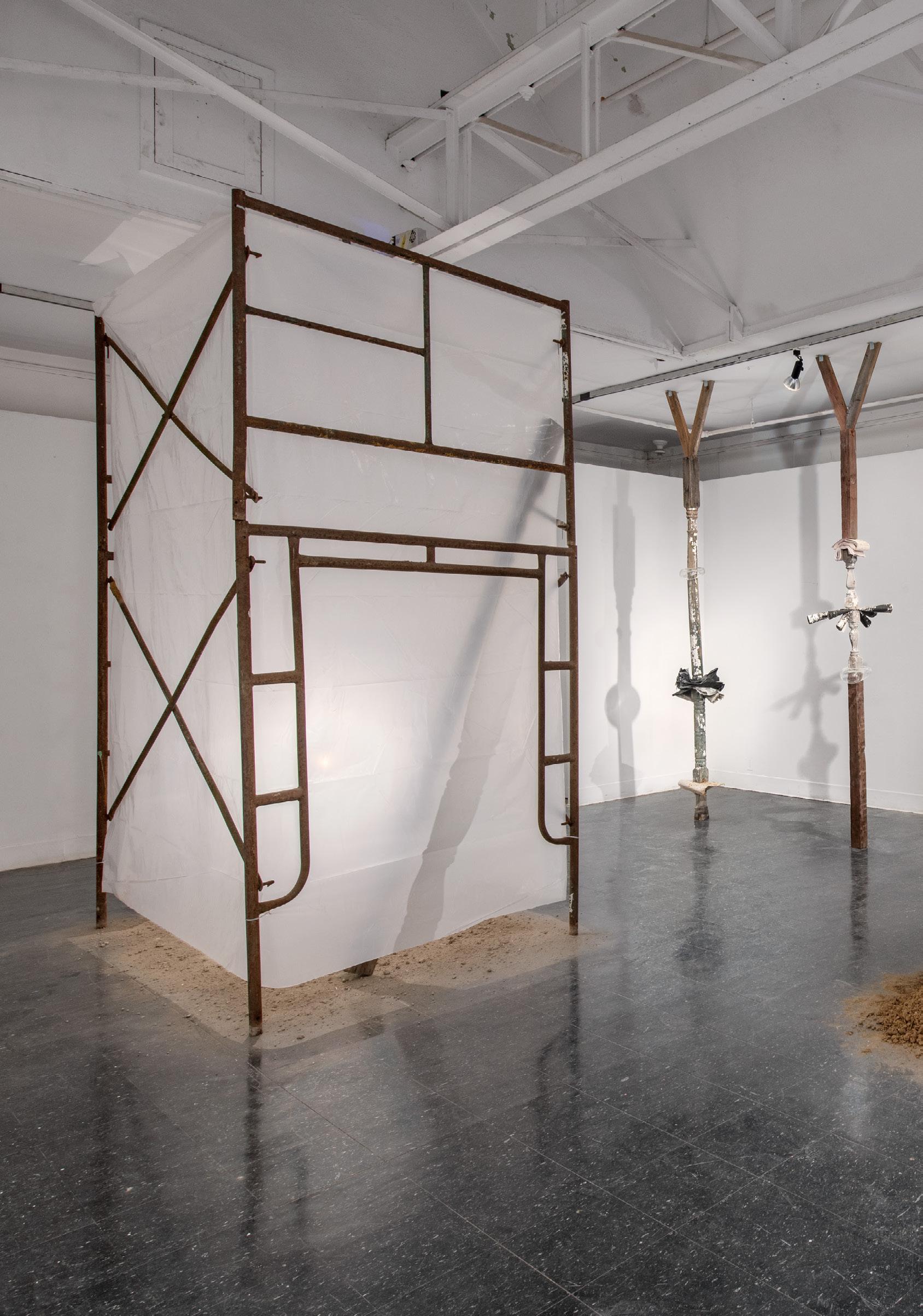

Through sculpture, installation, and printmaking, my work resonates with questions about how we situate ourselves in the world in relation to the information and images we consume. Collecting, mapping and archiving are the actions I use to explore subtle links between the natural and the artificial, the real and the facsimile, intuition and reason. In my practice, mapping, as a process, is inventing strategies to visualize information that makes new interpretations possible. My recent research investigates the distortion of reality in cartographic depictions and how they are presented to us as accurate images of a territory; this is critical in today’s context, where technology has created a new generation of cartographers who can manipulate data into any number of visual representations. I speculate about the image of the world we build through maps, the power relations they contain, and the information they deny and hide. Using scientific and historical references, I aim to create spaces for reflection on the fraught relationship that exists between the cartographies of a space in relation to its reality and our understanding of it. Through the construction of installations that explore terrestrial and celestial views, I question the stable definition of territories and representations of the past that have been considered true in the conception of our history. With the advice of astronomers, archeologists and geographers, I am developing work that examines the history of precolonial territories, creating proposals that make visible the gap that exists between the different ways of approaching the world.
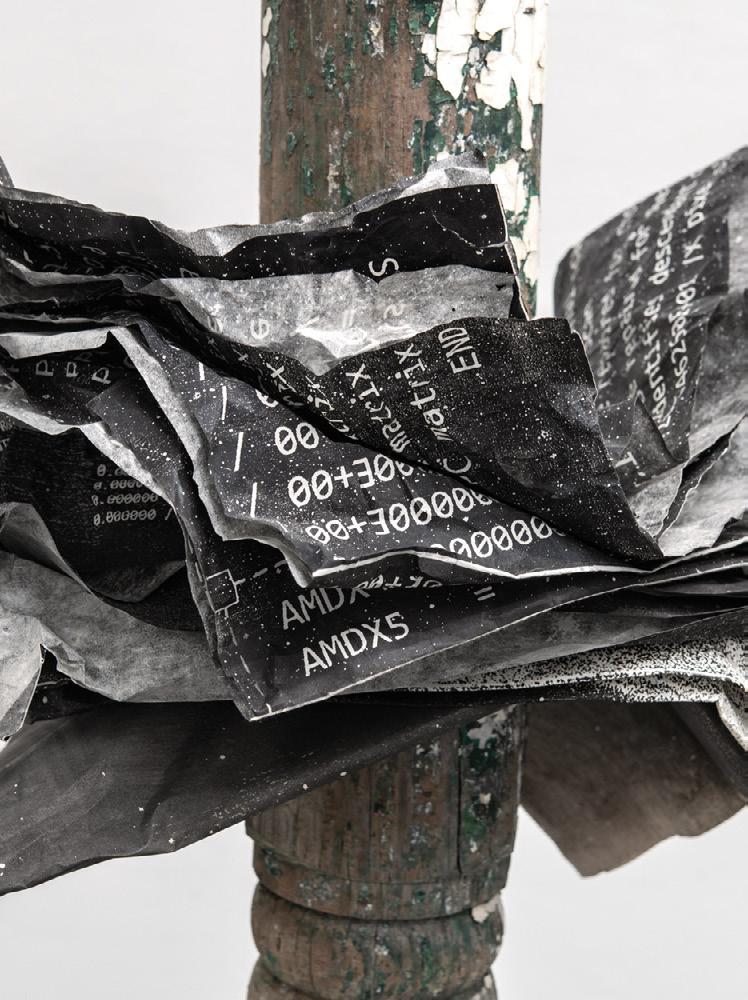
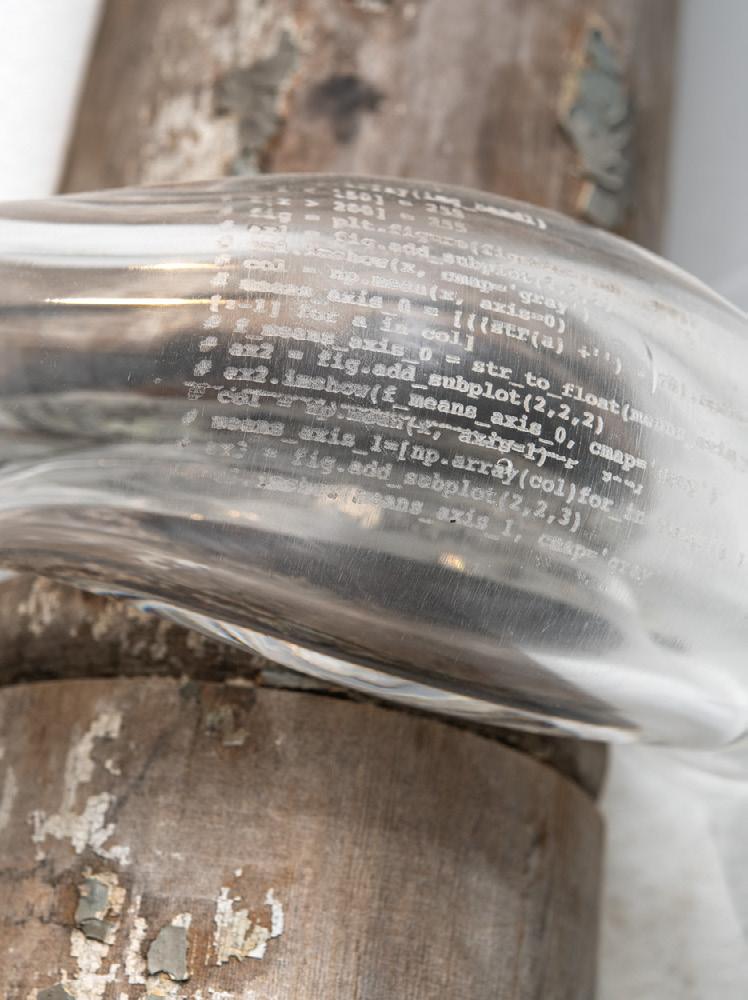 Installation view (p. 52–53)
Pillars (p. 54–55)
Blown and etched glass, reclaimed wood, woodcuts printed on Japanese paper and newsprint, and laserengraved paper
Four 132" high columns
Natalia Mejía Murillo
Installation view (p. 52–53)
Pillars (p. 54–55)
Blown and etched glass, reclaimed wood, woodcuts printed on Japanese paper and newsprint, and laserengraved paper
Four 132" high columns
Natalia Mejía Murillo
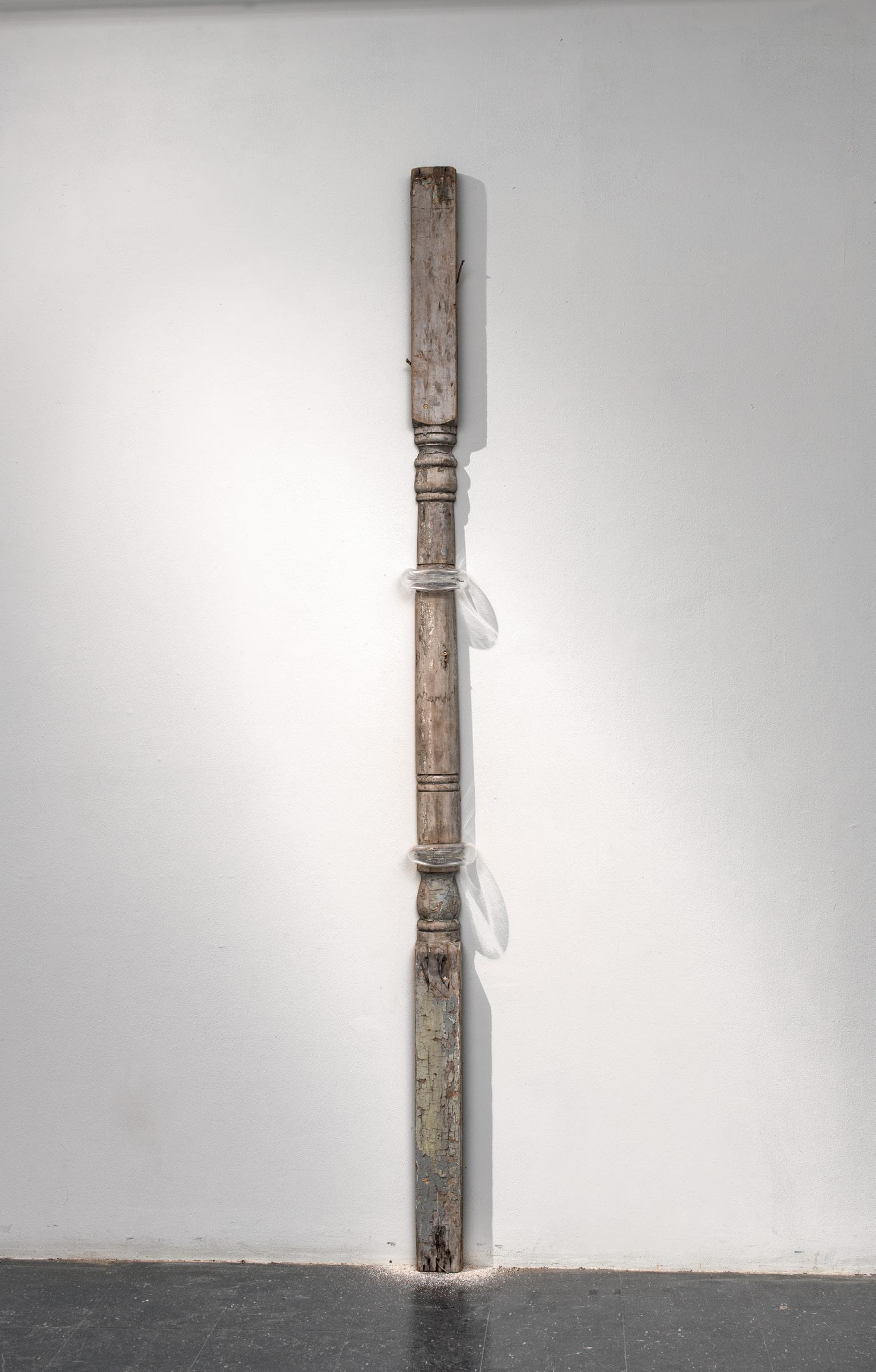
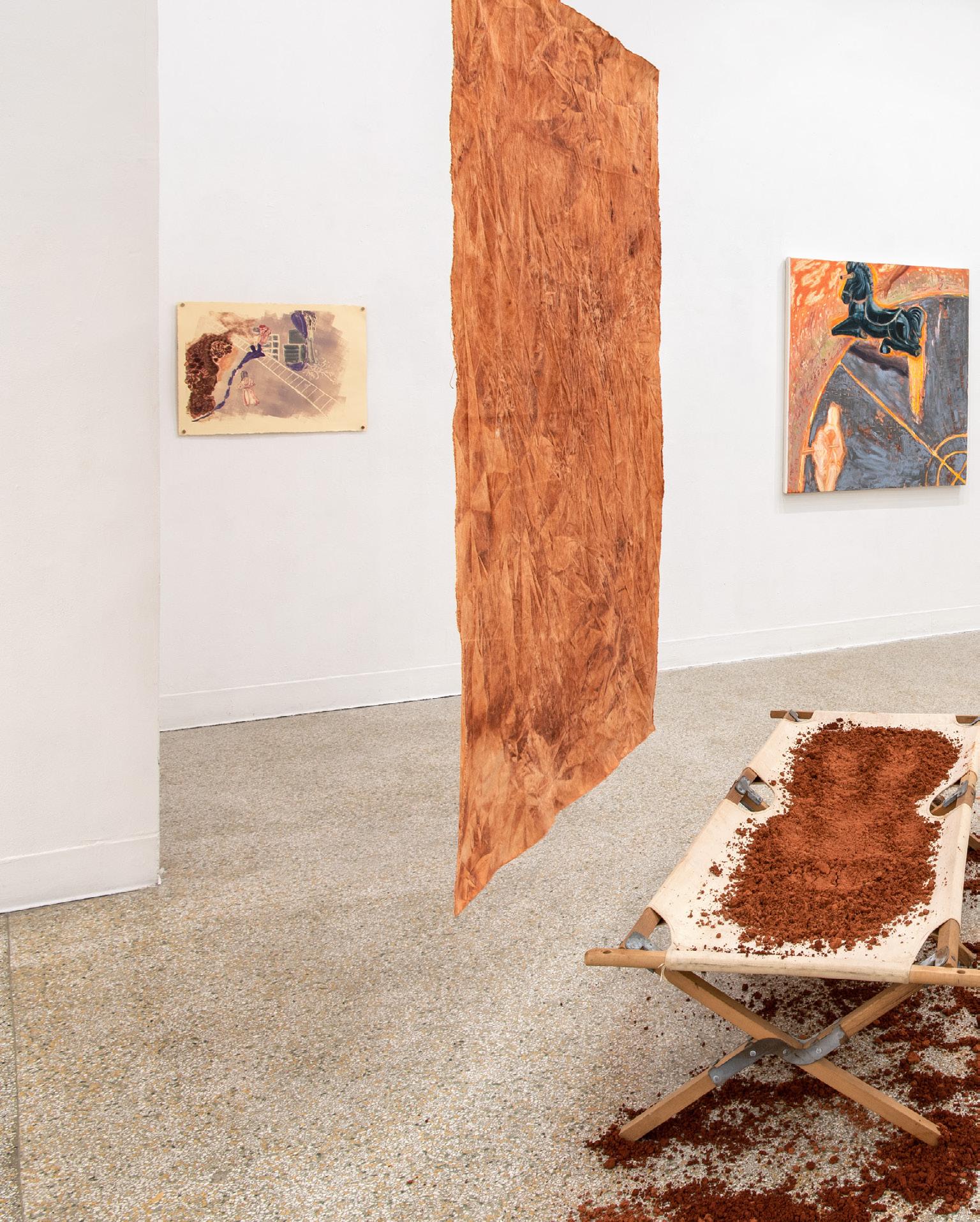

My practice circles an experience of how space takes up a place inside of us, where images can unfold and form their own inner geographies I think of my paintings as beginning with a gesture of laying-out a between-space, where the intimacies of waking dreams and visions are opened by, but also grow into, actual places, events and geographies. Following this movement between inside and outside—an outside at once mundane and spiritual— flimsy and ephemeral ‘inner’ sensory images, affects, and visions meet ‘outer’ landscapes of experience, while collective histories become fragmental archives of image-events. Painting, for me, follows a movement back and forth between inside and outside, with the body in the middle—the medium of this movement, the place of a ‘reverberation’ of images that
emerge where intimate space touches an outer immensity.
My painting practice develops the tension between ground and spirit through vernacular iconography—scenes grounded in the familiar yet shot-through with abstract forces—natural, spiritual, imaginary, mythological—that displace and haunt what was settled. I use ground as metaphor and substance: as fabulated spaces that ‘ground’ narrative images and sensations, and ground as earth, using red dirt as pigment or dye, composing a material geography. Exploring how the familiarity of place, home, or body is displaced—made uncanny by external forces, spectral sensations, or fugitive images—I abstract shapes/figures to open latent meanings and visionary geographies in my work.

Gallery view (p. 56–57)
Uterine Western (opposite)
Red dirt from Oklahoma, oil, and ink on canvas
34" x 45"
the assistants (triptych) (top, right)

Red dirt from Oklahoma, acrylic, and nails on found fabric
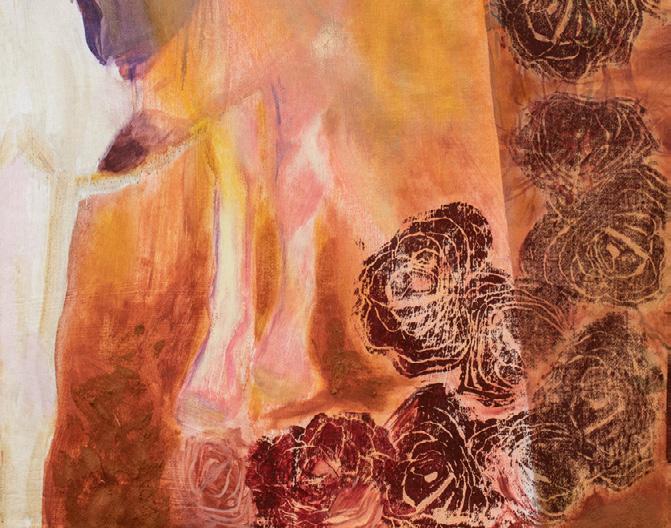
64" x 52" ea.
rose rock (bottom right)
Monotype: oil on paper
30" x 22"
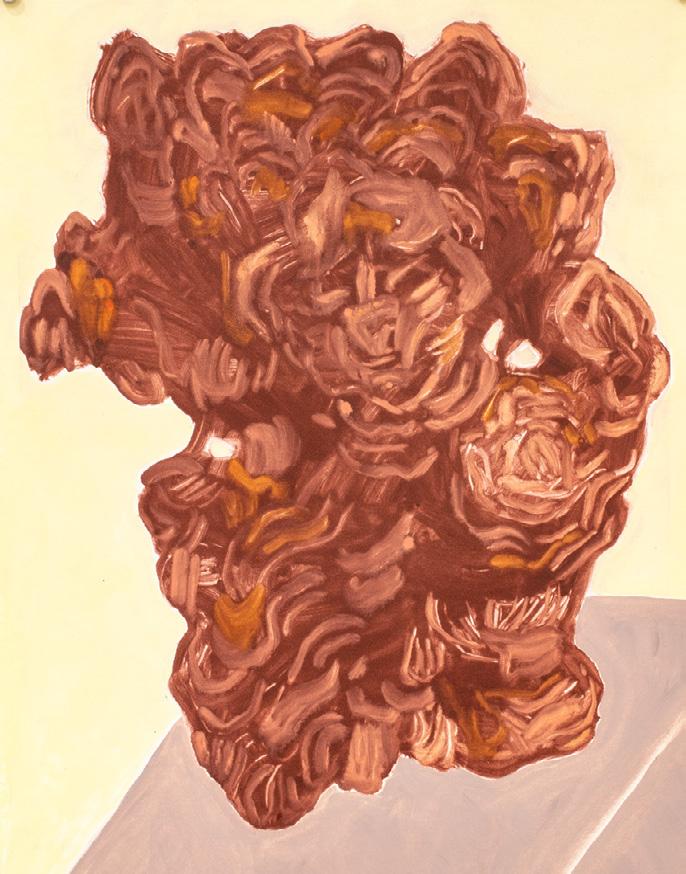

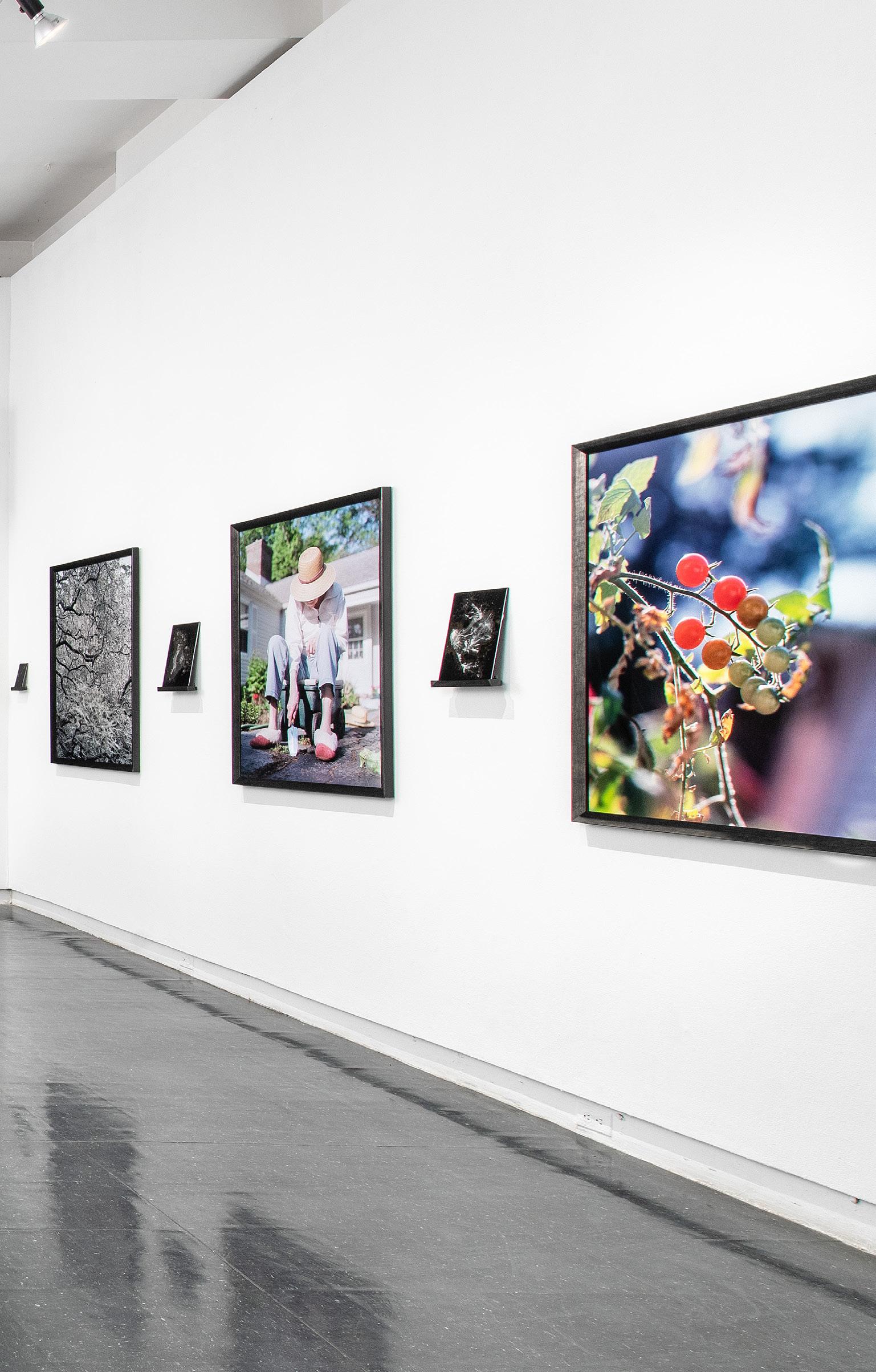
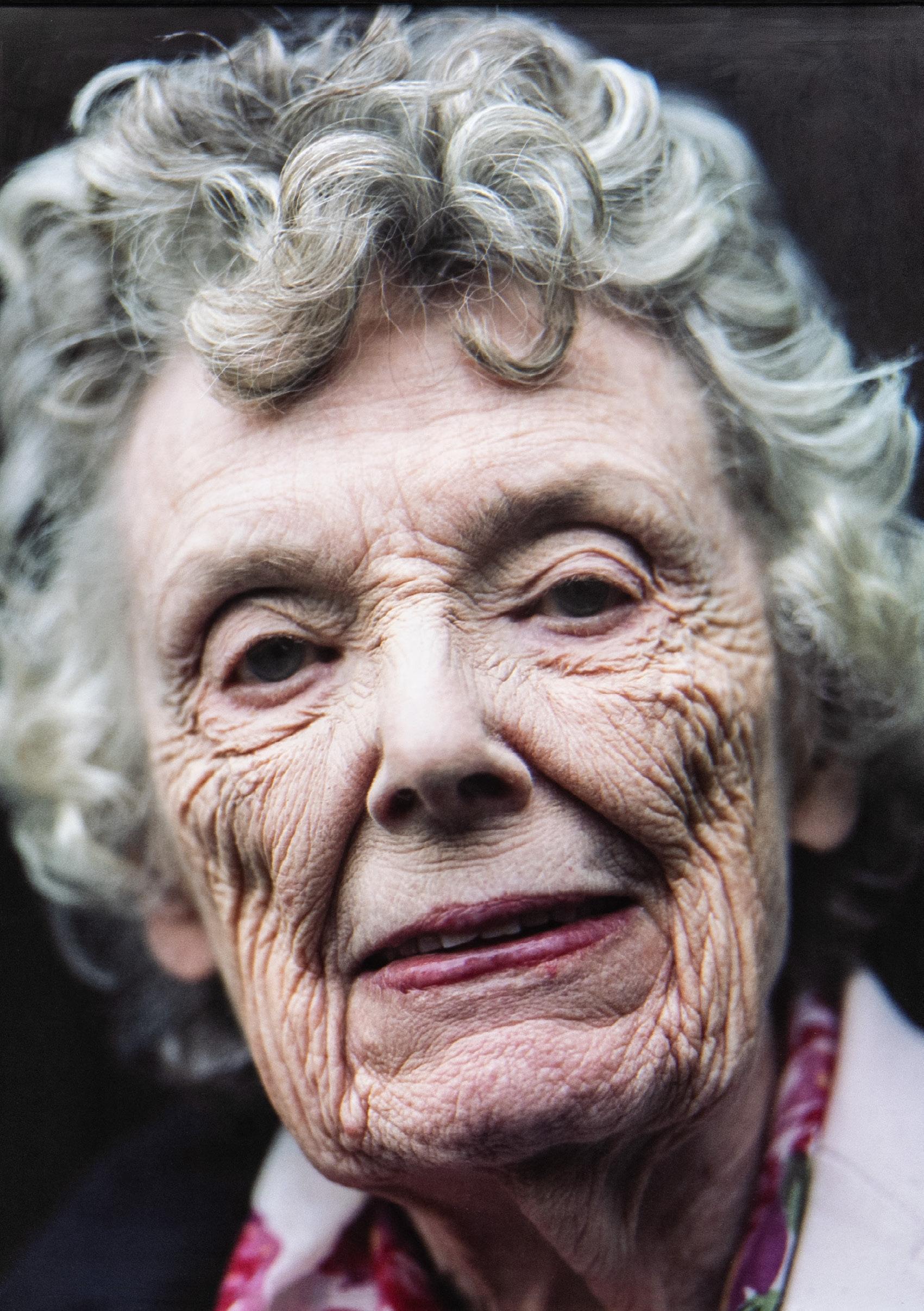
Madeleine Mae Morris
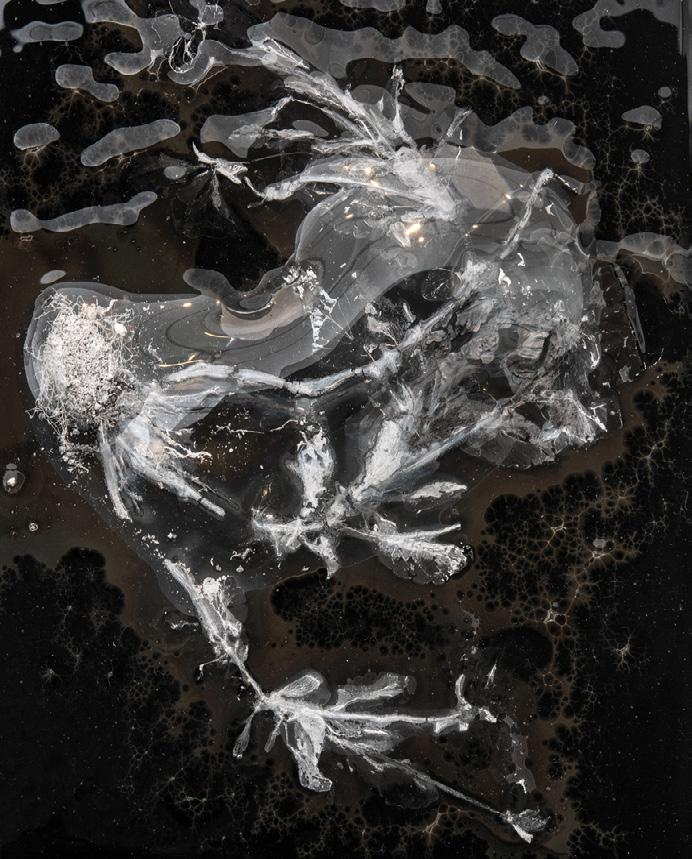
A Theory of General Relativity deconstructs the complex bonds between mothers and daughters—specifically my grandmother, my mother and myself. Being one of the subjects creates an interesting dynamic in which I both love and resent the other two characters. I try to be fair, but the conflict between sentimentality and objectivity cannot be avoided. At times, I am an unreliable narrator, but that doesn’t make what I say any less true.
Things changed in 2017 when I moved in to be my grandmother’s caretaker. I became obsessed with seemingly simple questions like: Who are we? How did we get here? What have we done to each other? What do we owe to each other?

Living with my grandmother brought these
life-long questions into excruciatingly sharp and unavoidable focus. In the room I was staying in at my grandmother’s house, there was a hydrangea plant pressing up against the window, facing an artificial hydrangea on the dresser, next to a painting of a hydrangea hanging on the wall. The only other decorations in the room were paintings of the Virgin Mother surrounding a mirror. I can’t remember it any other way. The subject of Nature is fundamental to my work, and to know my grandmother and mother is to know their gardens. I use plants as subjects to personify us, while also referencing the intrinsic themes and metaphors associated with nature. Do I reap what You sow? Can we only act according to our nature?


Manavi Singh
Rooted in Between is a personal project that delves into the connection and disconnection we experience while existing between spaces we consider home. Within this project, I have carefully selected a series of photographs and videos from a larger body of work that takes place in both my own and my parents’ homes in the United States and India.
The primary objective of this work is to explore the multitude of items and emotions that we carry with us as we move from one place to another. These may include legal documents, personal mementos, cherished memories and cultural artifacts. Each item we choose to bring
along reflects our priorities and values and can reveal much about our hopes, dreams and fears. Through this project, I also aim to address the complex emotions of isolation, acceptance, silence and lack of expression that exist within certain societal norms. Specifically, I explore the coping mechanisms that my grandparents and their children have adopted as they navigate life in foreign lands, struggling to find a place where they truly belong. Ultimately, this project highlights the experience of being in between and the deep emotional baggage that we carry with us on this journey.
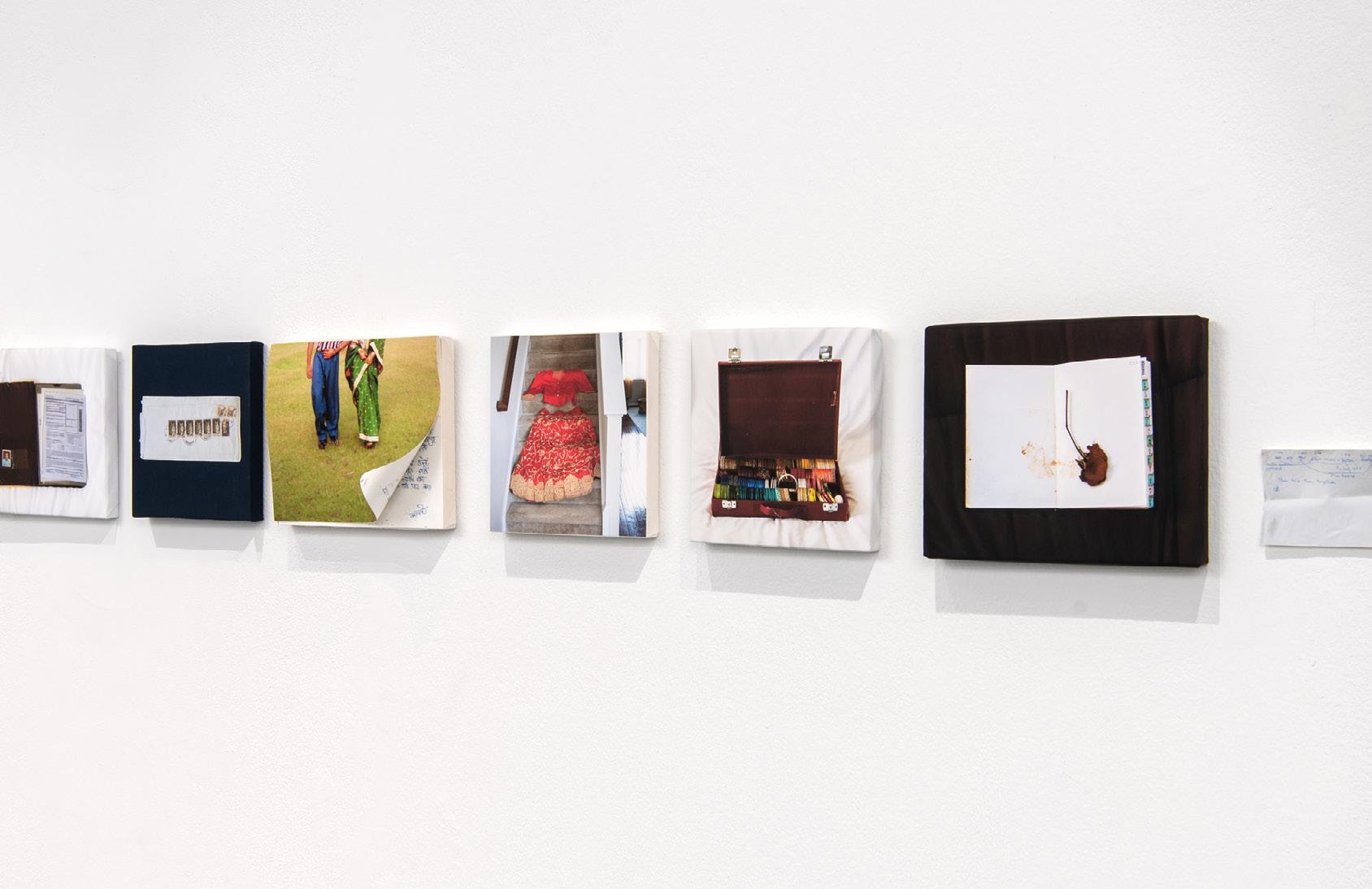
Untitled (p. 64)
Dadi (p. 65)
Nani’s Roof (p. 65)
Digital photograph, Moab Lasal Exhibition paper™, dark walnut stained wood frame
28" x 36"
Packed (p. 66–67)
Multiple images wrapped on wooden canvas, fabric, matte photo paper, family archival prints

8" x 10" and 8" x 8"



I breathe in and out, repetitively, rhythmically, consciously and unconsciously. I move in the space, around the space, away from the space. I remain still, while moving in the most indiscernible way, in the most minuscule measurements of time, thus seemingly still. My eyes reach for the furthest on the other side of the peaks. My ears search for the widest above and below the waves.
I remain distant to the surrounding beings as they remain distant to me. I constantly look back, to reexamine

every word being said and exchanged, to reevaluate the states of mind. I dive deeper and deeper inward, to understand this person who is me.
I yearn for the delicate, the transient, the palpable yet still intangible. I yearn for the phenomenal dynamics embodied in the fluid state of the body, constantly in conversation with the mind. I create visuals and sounds, hoping to elicit the secretive electrical currents, which I once and again experience when I have a bodily reaction to a thought of mine.
To, From
Live performance of live acting, film screening, and multi-channel sound 00:47:00


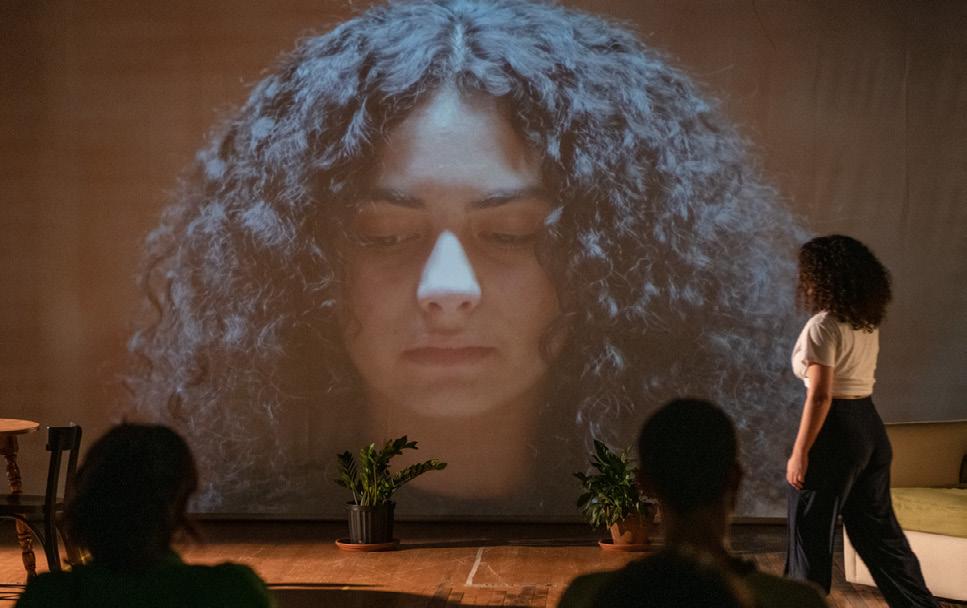
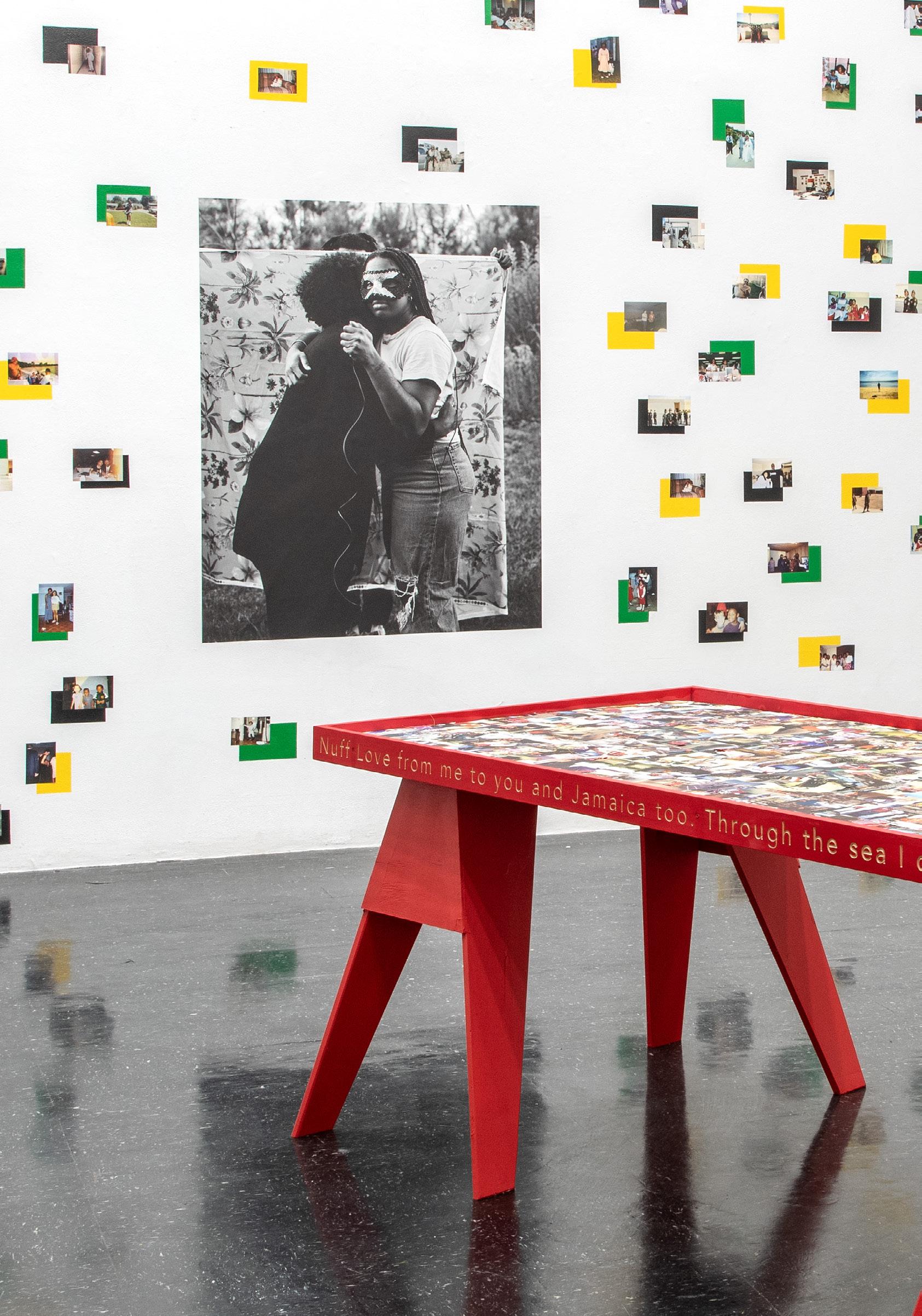


Katherine Thompson
My mother once said, “Rise up and make a difference. You are in this country. Now act like you are free.”
My work is focused on the power of the diasporic memory of immigrants and its effects on identity within the family structure, particularly those who came after. The unpacking of this unveils those distant and absent attributes that reside within the home. As a second generation from a family who migrated to the United States, there was little room for a binary identity. For myself, this constant state of in-between-ness from both spectrums, Afro-Jamaican and American, later brings further questioning of selfhood outside this maintenance of a Caribbean identity through generations in the family space, that is not just transnational. There is something deeper to be said about the internal actions of alienation, assimilation, and authenticity that are never mentioned. Through lens-based practices married with textiles, I question the conversation of the universal message of a shared interconnectedness with the immigrant experience that potentially could be borderless and blur the lines of what constitutes a transnational identity, particularly Black/Brown groups.
We are all connected to one another by complex common threads found within our family memories.
Installation view (p. 72–73)
“Call You By Denise, My Mother’s Name...” (oppostie)
Archive reprinted on adhesive photo vinyl, acrylic 83" x 4" x 115"

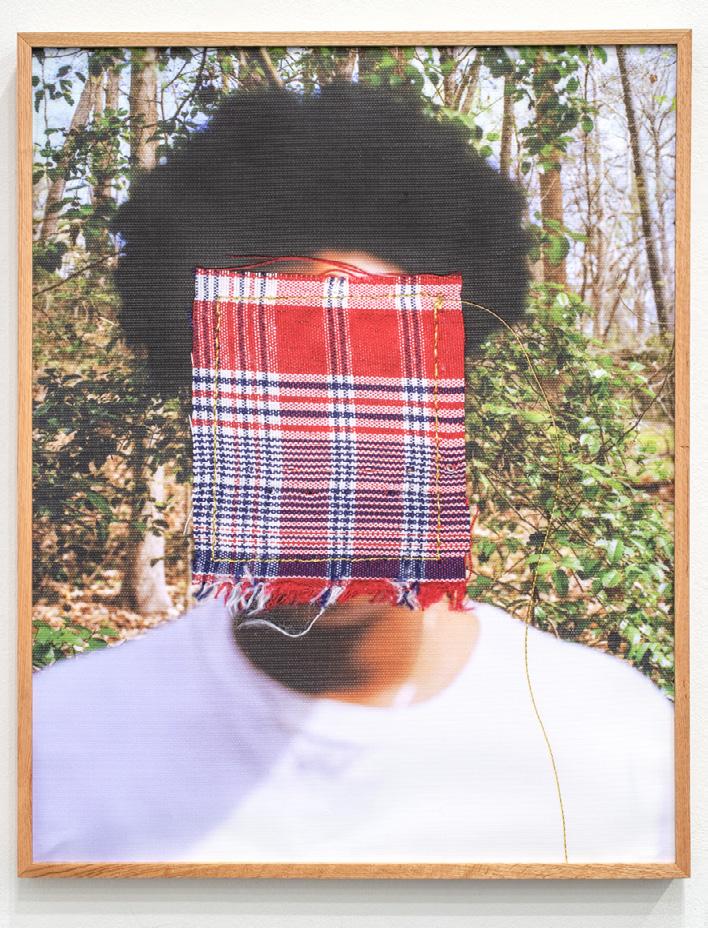
Untitled Self-Portrait (right top)
Archival inkjet print 35" x 44"
“RGBY” (right bottom)
Engraved acrylic, archives reprinted on adhesive paper 19" x 25"
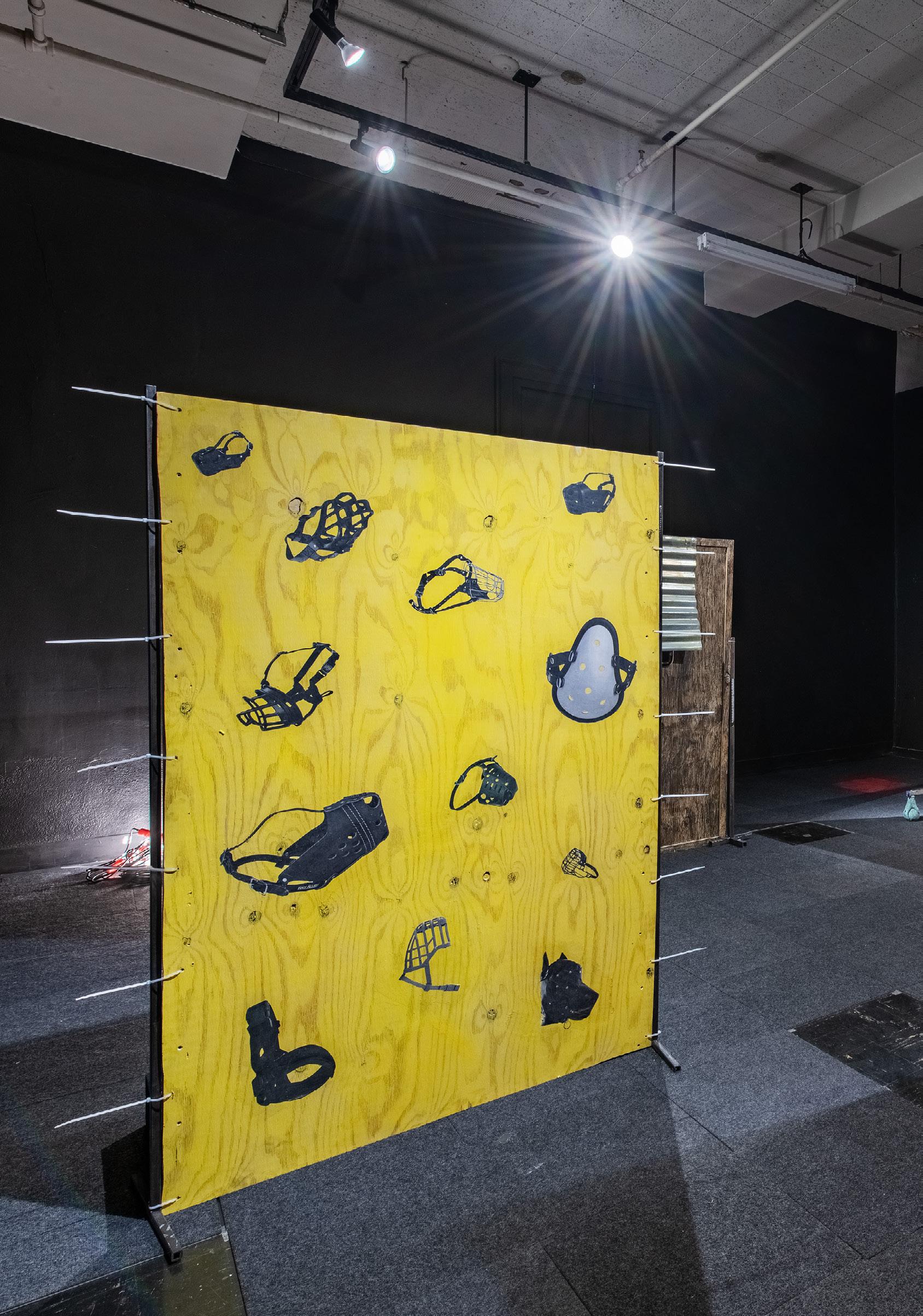

Vaseline, steel, plywood, pigment, duct tape, coated spandex, snaps, china marker shavings, bronze, rubber, felt, epoxy clay, hardware, newsprint, graphite, plexiglass, latex, stolen anti-theft mirror, work light

Variable dimensions

effie bowen
My work examines how systems of power influence movement, agency and attention. Through my sculptural, performative and imagebased work, I critically engage with prefabricated materials through a formal, absurdist lens. I saturate common objects and habitual behavior with acts of repetitious gesture and skewed position in order to excite close attention and embodied agency.
My projects cut through the invisible haze of systems that effectively cordon social behavior. I am attracted to forms which act out power dynamics of use and intent like bollards, dog bowls and stanchions. My critique of authority and mastery emerges as urgent
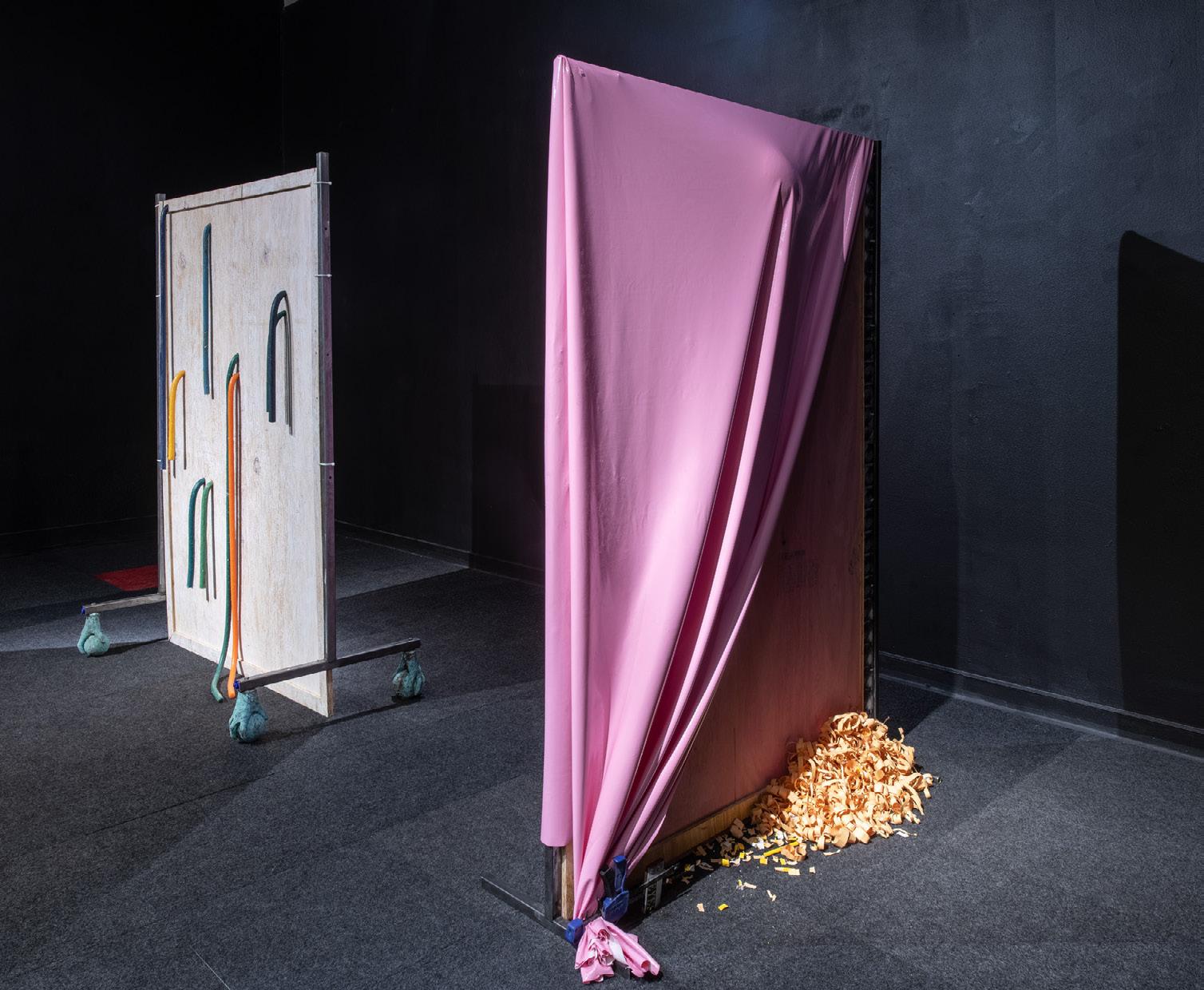
and mischievous as I incorporate dark humor, wordplay and color in my works as gestures of subversive levity.
Dedicated towards an anti-disciplinary approach to art making, my projects engage specifically with their host environments while they feed and foster their own aesthetic proclivities. Imbued with uncanny resonance, the subjects in my works are mischievous, unfixed and responsive to circumstance and change. Fascinated by working with things as they are, I approach space-making and worldbuilding, not ‘from scratch’, but instead using poetic intervention to look anew at what is easily invisibilized inside of the habitual and common.
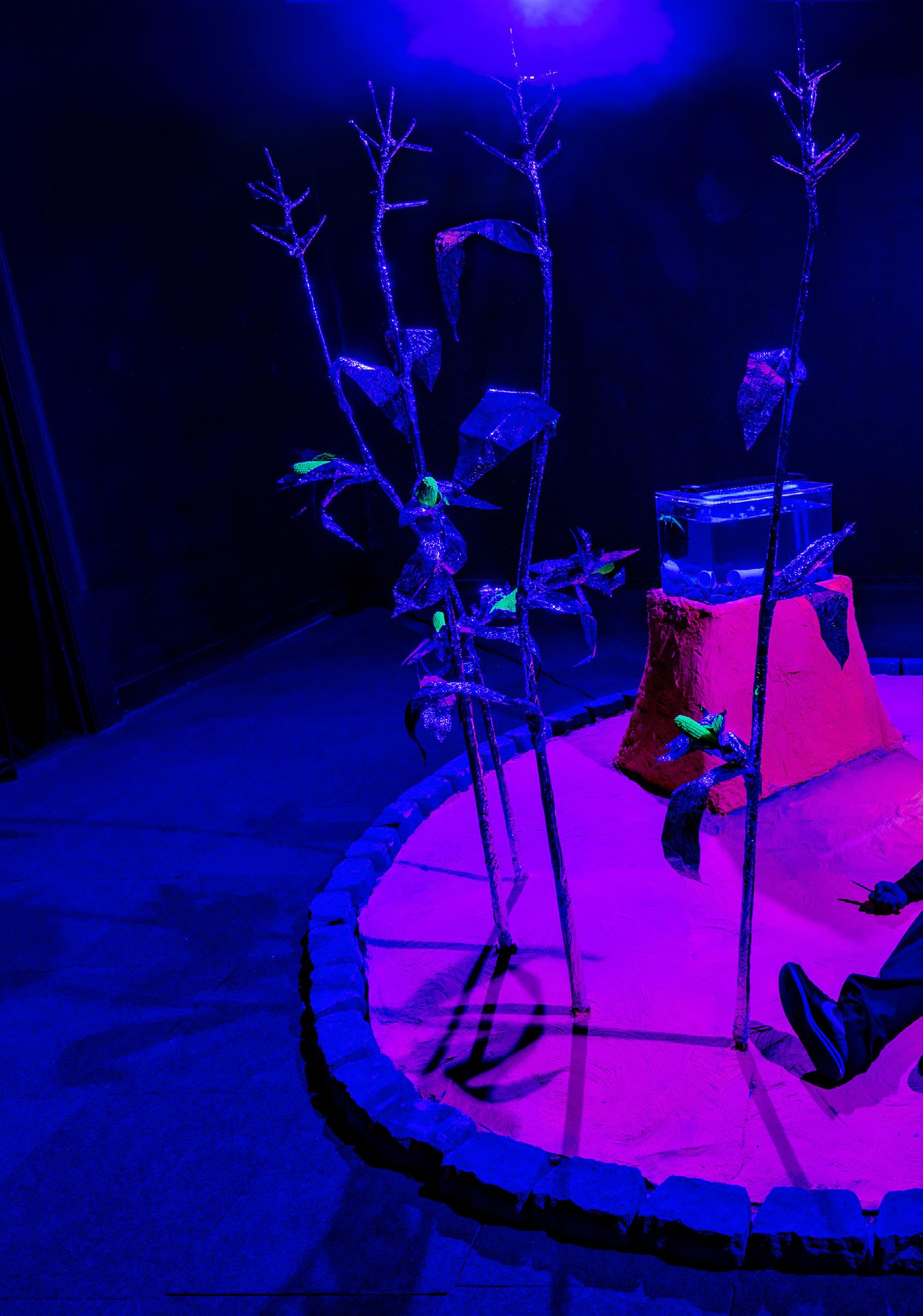
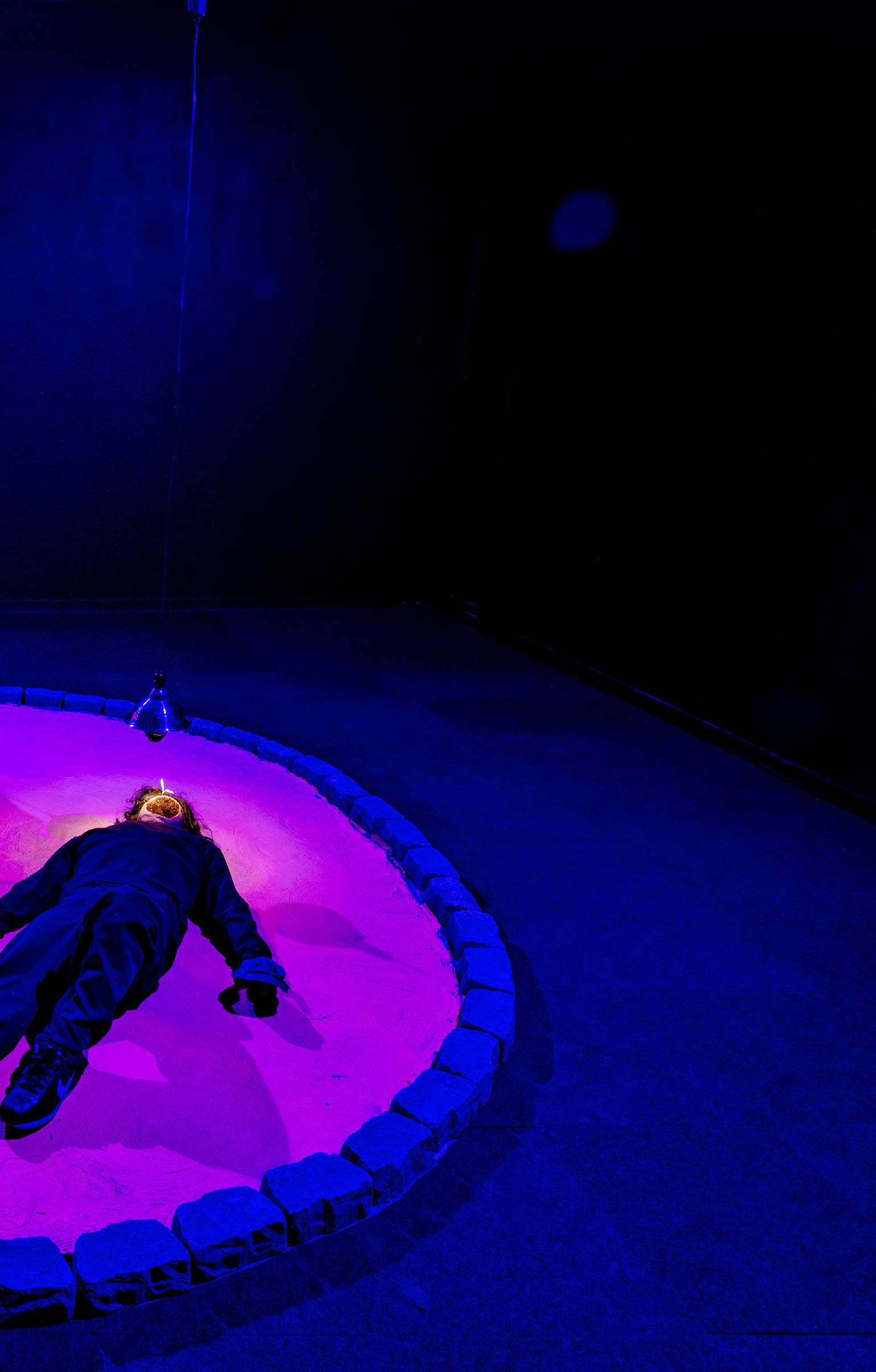
Morphic Radiance

Wood, glass, sand, epoxy, metal, mylar emergency blanket, foam, concrete, cotton, polyester, silicone, dirt, maíz (zea mays), ash, chalk powder, rubber, acrylic, rocks, Axolotl, (Ambystoma Mexicanum), blood, sweat, tears, saliva 11' x 11'
 Daniel Cab Carbone
Daniel Cab Carbone
A space between experience and encounter. An electromagnetic field of emergence and perpetual becoming, in a state of concurrence with those that came before through transtemporal radial adaptivity. The encounter between the m/other; the I and then non i, existing between the real, the imaginary, the symbolic. A supernatural shift between worlds examining the present and recent past, all while reimagining the future. A galactic radial immersion into the deepest recesses of the corporeal. A simultaneous
deterritorialization and reterritorialization across thresholds of identity and memory inhabiting the Matrixial realm.
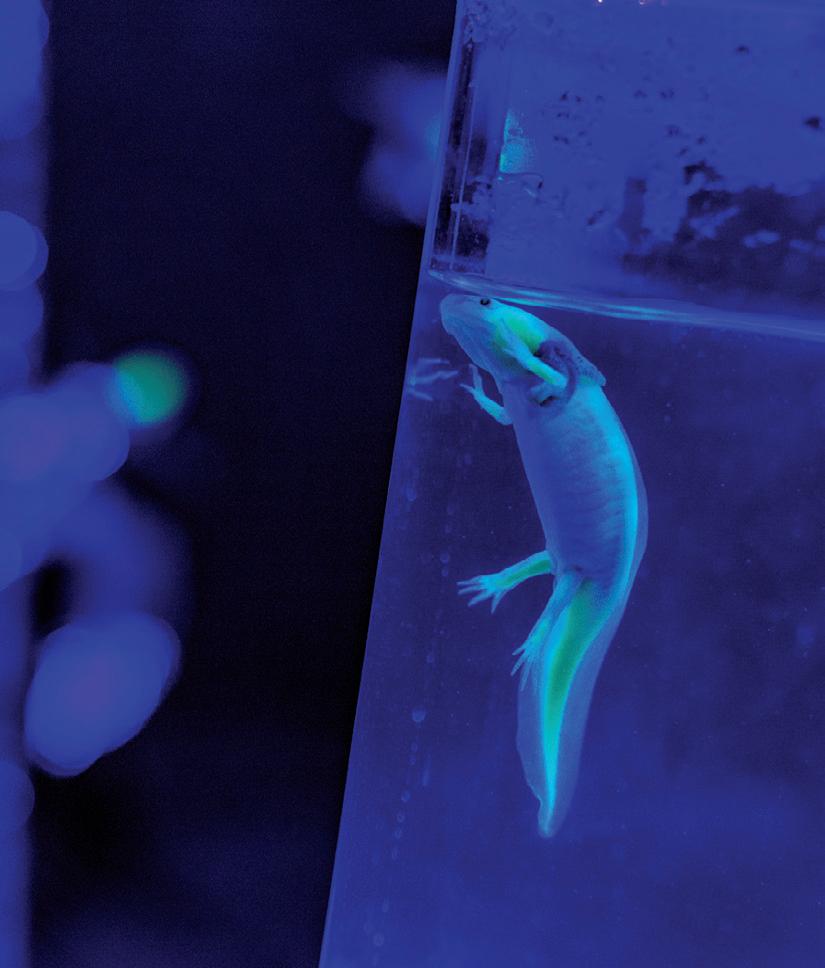
A harmonious magical experience awaits if you dare to remove thyself from thyself. The culminating experience is a startling spectacle filled with divine and majestic wonder sure to shock and delight viewers of all ages.
Rated PG-13. Approx. run time: 20,160 minutes.





A few years ago, while I was asleep, my brain arranged this dream for me:
In a room with my brother. The wall in front of us has a window in it; outside there’s rolling grassy hills that remind me of learning to draw in elementary school. We witness a blinding flash on the horizon. It is unclear if it’s an asteroid or nuclear bomb but all I know— am filled with a profound sense of understanding of— is that we will not survive it, and I have x amount of time left with him.
Dream time is malleable to your needs. Some seconds pass over the course of five minutes, others are skipped in big blocks.
We watch as the blast wave crests hill after hill. I know that I have thirty seconds until it hits, fifteen seconds to say everything I need to say to him, twelve to ask him every question, four to resolve our relationship… two seconds, half a second, a quarter of a second… one eleventh, twelfth, thirteenth of a second… one thousandth; it’s blowing the glass out of the window… one millionth; it’s burning my lips off as they move—
I use my practice in an analogous way, to diagram spaces or relationships of exponential scale or complexity and suspend them in an extended study. Found images and forms are rendered with earthly materials that speak to the frenzied ache of living in, as they say, interesting times.

Daniel
Untitled (legend) (opposite bottom)
Local coal
Largest piece: 4" x 3" x 1"


Aida Lizalde
I create sculptures and installations with ceramics, found objects, and biomatter. These hybrid objects exist in spaces of transformation, such as a stomach becoming a tree trunk, an intestine becoming a territorial marker, or a pot becoming an anthropomorphic machine. The materials I use, like clay, pinto beans, hair, guajillo peppers, and found objects, arise from memories of my upbringing and my cultural background, like digging my hand into a bucket of raw beans, scraping the yellowing crust of handmade cheese, or kicking the red clumps of dirt off my shoes in my grandfather’s ranch.
My work explores the inner workings of the body and the ways in which it struggles to metabolize the vast array of data that it processes; the complex interplay between the physical and the psychological and the natural and the artificial, alongside the potential for harmony and failure in these relationships. It explores those through systems that drip, strain and dissolve. It is also in contact with concerns such as post-colonization (the effects of colonialism on people and their survival), generational memory, identity, disease and trauma.
I am kin to artists of the Brazilian avant-garde movement of Antropofagia and the surrealist literature of Leonora Carrington. I am interested in the blurring of boundaries between objects, organisms and technology as explored in Donna Haraway’s “A Cyborg Manifesto.” These propositions expand metabolization to the processing and transformation of reality through inward and outward systems, including flow, drip, filtration, stagnation, bacterial growth and decomposition.
Installation view (p. 88–89)
Untitled (top)
Untitled (oppostie) Clay slip, water, ceramics, retired fire hose, wool, wire, jumper cables, extension cords, compost, natural rubber, found hoses, metal hardware, etc.

Untitled (bottom)
Goat’s milk, bacterial cultures of spit and vaginal secretions, vinegar, sugar, wood, plastic, cotton-poly dropcloth, guajillo pepper stain, bug stench
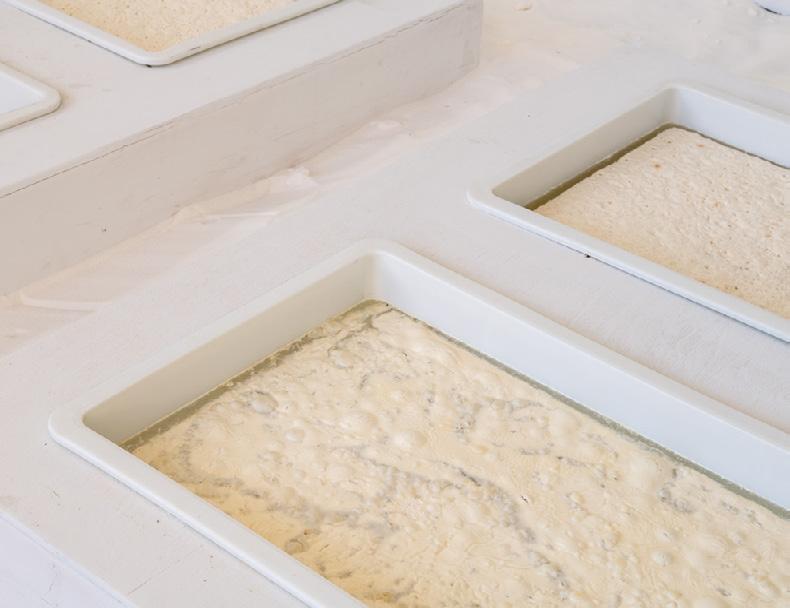

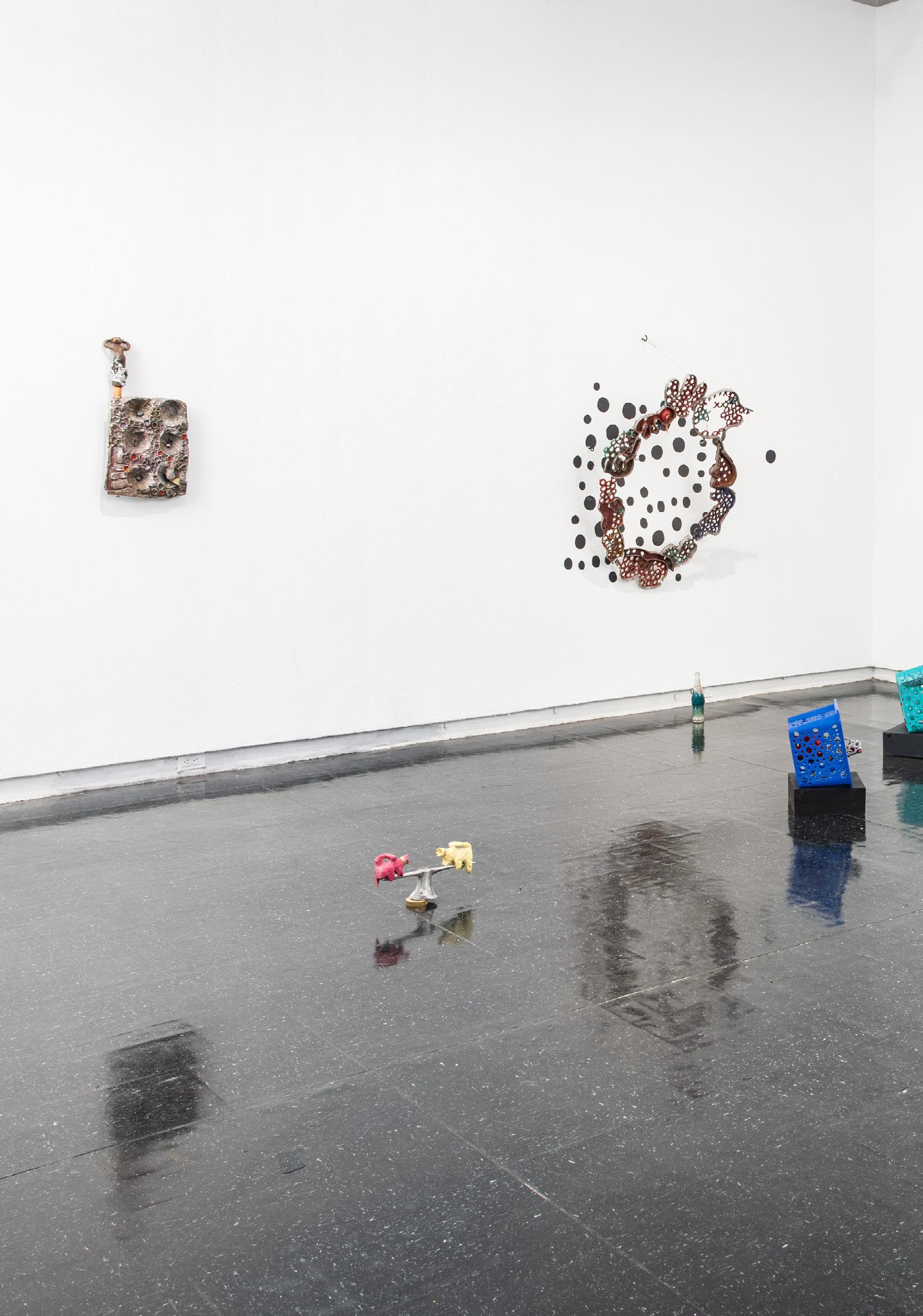
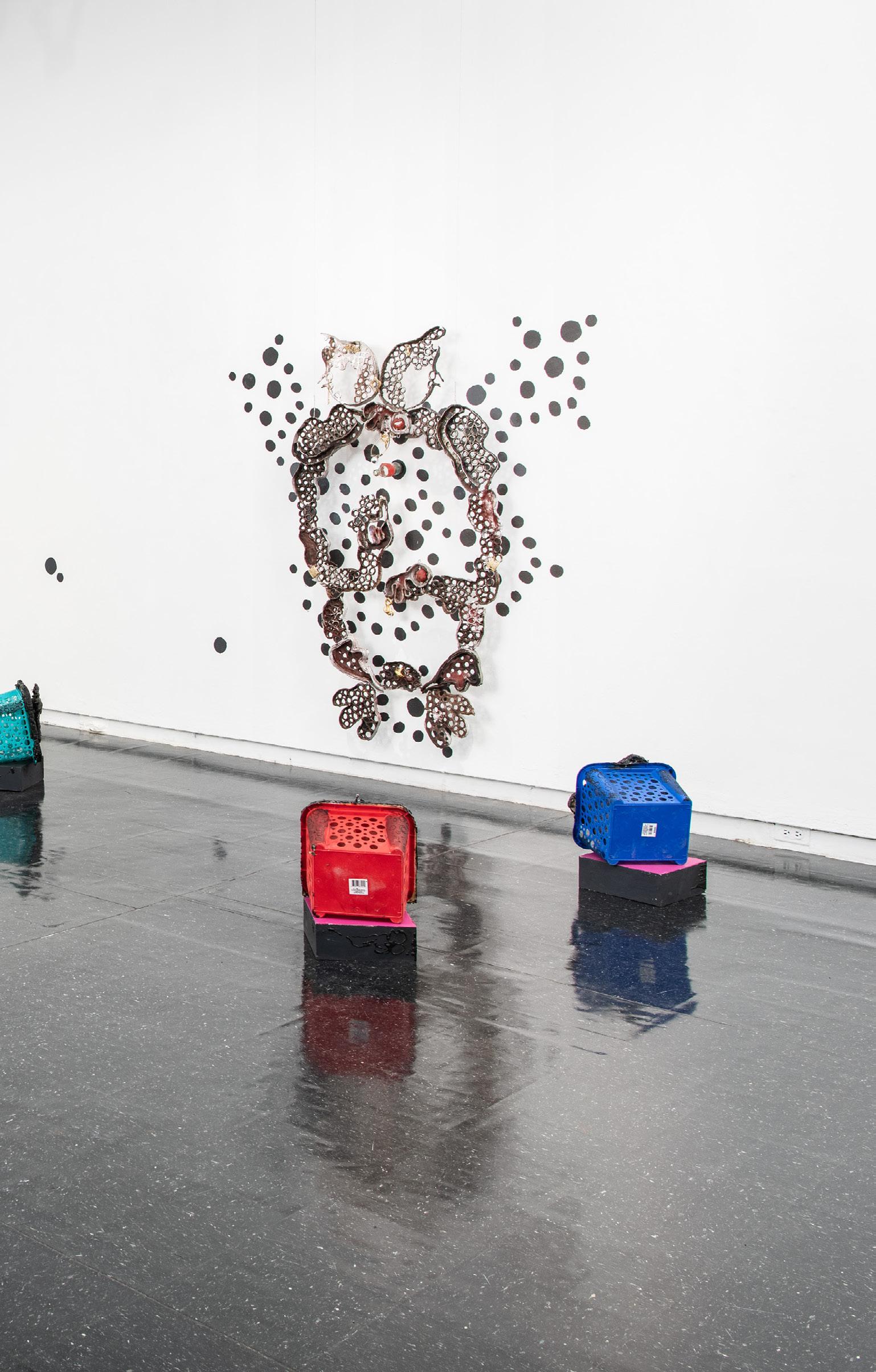
Installation view (p. 92–93)
Kunyangira yaona (iii) (above)
Aluminium, peephole, wood frame 13" x 9" x 2"
Pasee-saw (top right)
Resin, aluminium, brass
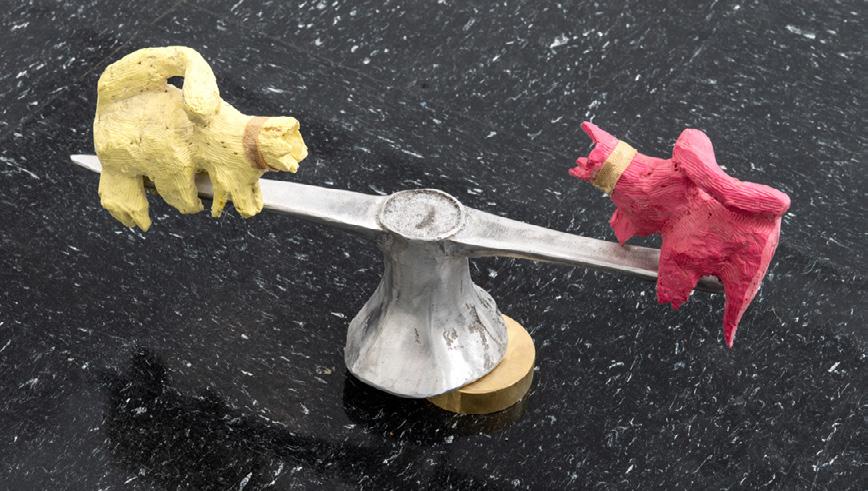
4" x 13" x 3"
In-Habi-ted (i) (bottom right)
Aluminium, coca-cola bottle, Asphalt, plastic baskets, urethane, jewelry, acrylic paint
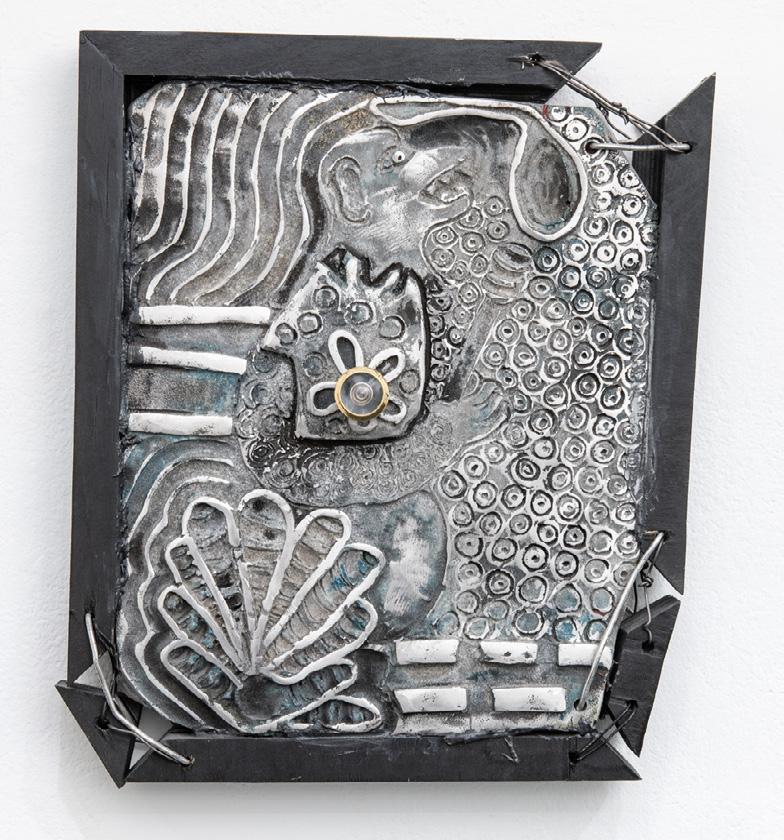
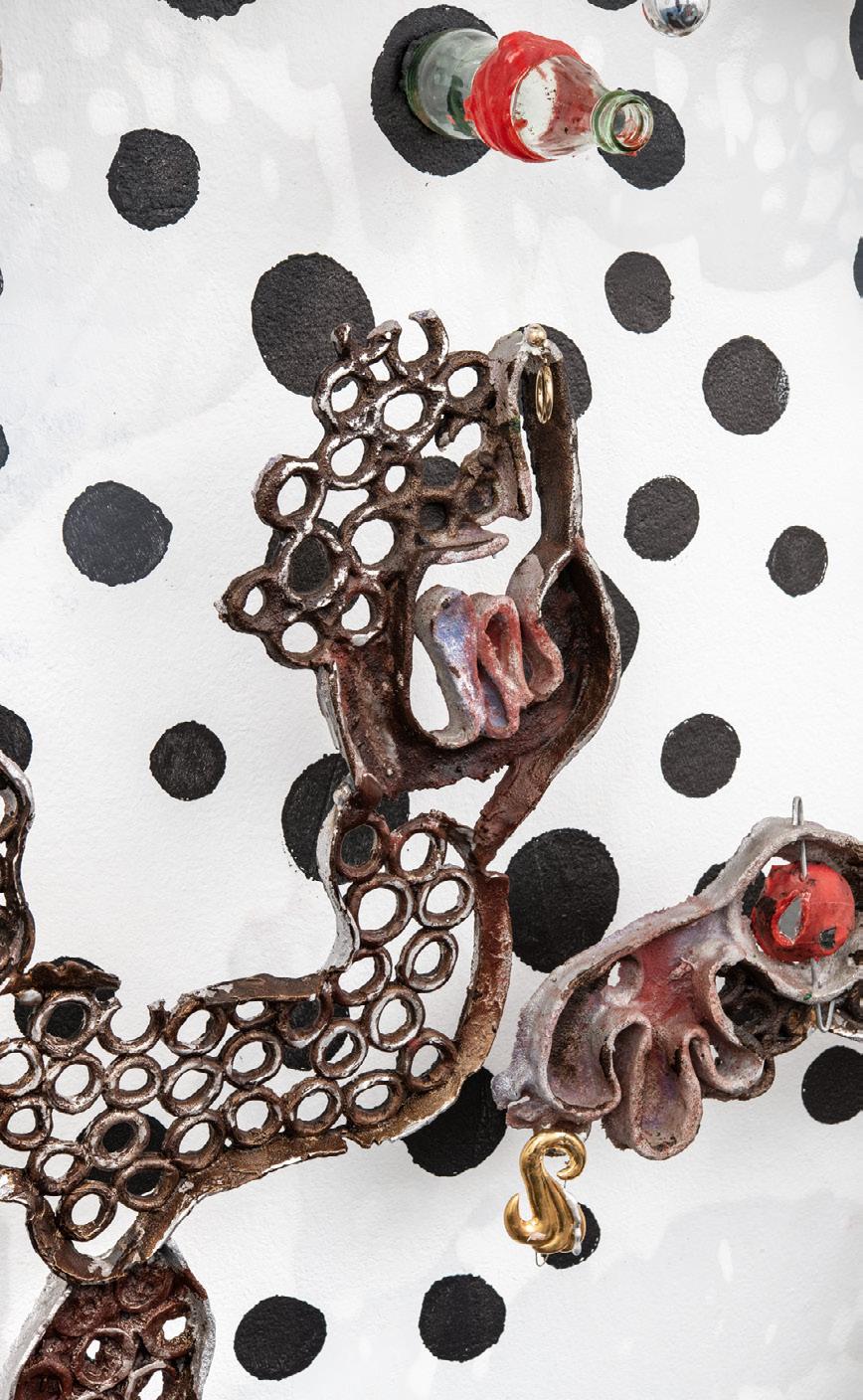
Variable dimensions
In-Habi-ted (ii) (opposite)
Aluminium, ceramic, peepholes, string, earpod 19" x 12" x 3"
As a multi-disciplinary artist, my work includes site-specific installations, sculpture, printmaking and painting. My projects explore meditative and mindful practices such as sitting still and having conversations as well as prayer and ritual in the setting of traditional architectural spaces and in sacred spaces in nature. I examine the complexities of collective meditative states and the contradictory aspects of the urban and rural psyche in modern-day Zimbabwe.
I create paintings and sculptures with philosophical references to his totems and taboos. In my installations, I reconstruct and deconstruct sacred spaces as interactive spaces to explore the struggles of modern Zimbabweans to reconcile traditional culture and new autonomous subcultures. These subcultures become new and curious beasts that are given form in my sculptures, paintings, and prints. My work is preoccupied

with interrogating the systemic postcolonial footprints that haunt to erase indigenous knowledge systems.
A common feature in my work is the combination and assembling of materials that trouble the line between mundane and ritual, not only in Shona cosmology but in several indigenous philosophies. My work takes various forms and assemblages and common among these are continuous lines with eternal interconnectedness. These various iterations and persistent line forms act as coordinates to investigate the mythical cosmologies and meanings of peculiar metaphors, idioms and proverbs, as well as speculative and paranormal ideologies within urban and indigenous subcultures. My work is an allegory that is interpreted through the world of symbols, totemic symbols, ancient language systems, and indigenous motifs.


Rupeng Zhao
The project The Game of Absolute started from my research of the many manifestations of mythology and religion. I attempted to recreate the form of the “shrine-sacred text” in a personal language. I take all the space, or the visual part of a certain cosmology, world view or ideology as the shrine, just as churches and icons. And I take all the text and symbols they use to explain themselves as the “sacred text”, like the Holy Bible. The “shrine” deals with the question of how the basic elements that build the world related to a specific space, and interact with each other. The “sacred text” deals with the question of where these basic elements come from. I use the concept of “absolute” to
investigate the unshakable symbolic order in various mythological materials to pick some of them up to construct my work. Among the universal elements of mythology I reference are the birth of the sun and the moon, the battle between good and evil, and sacrifice. Those that have survived through the layers of history are achieved their absolutity—the highly abstract and unshakable component of the inner spiritual framework of the universe.
By writing myths, creating icons and constructing shrines-like-boxes, this project attempts to build a field to reproduce my personal cosmology to embrace this kind of absolutity
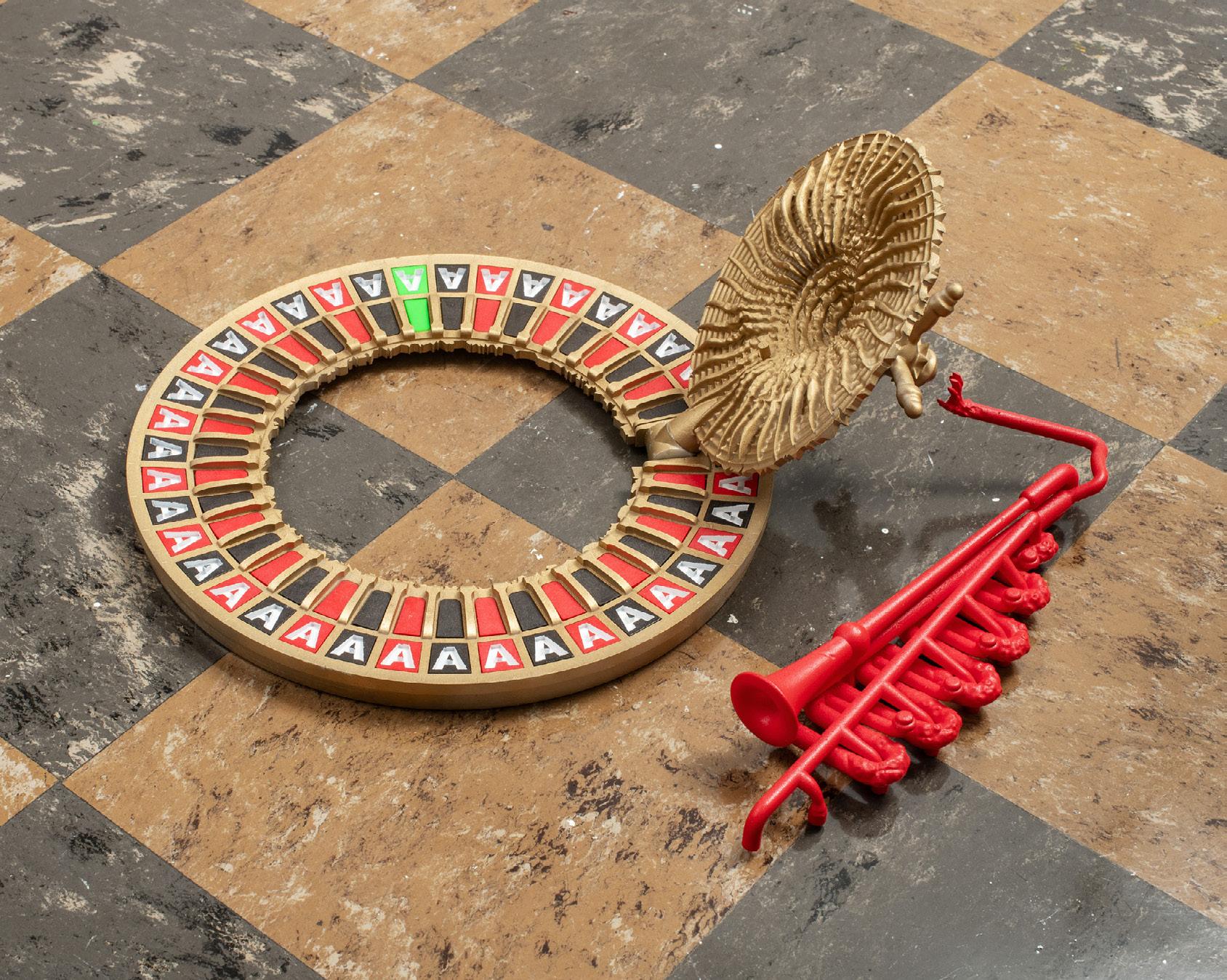
The Game of Absolute 3d printing, acrylic sheet, digital printing, wood Variable dimensions


Cover Image
Lindsey Arturo (M.F.A. ’23)
Photography Terry Brown
Design Shanice Aga
Virginia Commonwealth University School of the Arts
Pollak Building, Suite 201 325 North Harrison Street Richmond, VA 23284-2519
